Books Vs. Movies: Similarities and Differences Essay
Books vs. movies – introduction, similarities between books and movies, difference between books and movies, works cited.
This paper examines the similarities and differences between books and movies. Although both tell stories and evoke emotions, they also have distinct characteristics. For example, books rely on the reader’s imagination, while movies present a pre-determined visual interpretation. Another difference between books and movies is that books typically offer a more in-depth exploration of characters, while movies may prioritize visual spectacle over character development. Despite these contrasts, both books and movies have the power to entertain, educate, and inspire. This essay compares and contrasts the two products in detail and provides examples from famous works.
Books and movies are two of the most important mediums for communicating ideas to an audience. The two can be used for various purposes, including entertaining and informing. Books make use of written words to communicate with the reader. On the other hand, movies utilize audio-visual technology to communicate with the viewing audience. Books and Movies have several significant similarities and differences.
A major similarity is that both books and movies set out to tell stories that are often fascinating to the audience. Regardless of which medium is being used, efforts are made to create stories that are going to be engaging to the reader or viewer. For both movies and books, the story is a central part, and the authors or directors come up with themes and plotlines that can captivate and entertain the audience (Bordwell and Staiger 262). By using elements such as characters, setting, conflict, and resolution at the end, book authors and movie directors can come up with successful stories.
Another similarity is that both books and movies make great use of characters through whom the story is told. Bordwell and Staiger note that the characters used must be well suited to the story, and they must be clearly distinguished from one another (262). They are given personalities and used to fulfill the key elements of the story being told through the book or the movie. In most cases, it is the characters that make the audience regard a movie or book as superior or inferior.
A significant difference between books and movies is in the manner in which the visual images are created. When reading a book, the reader has to use his/her imagination to create a visual image from the words contained in the book (Mayer 17). For example, in the Harry Potter books, the reader is required to form his/her own image of the various magical creatures. On the other hand, movies present the reader with a ready visual image. In the Harry Potter Movies, the images of creatures such as trolls and goblins are presented to the audience. The imagination of the viewer is not required since the movie makers have already created the image they want the audience to have.
Books and movies differ in the level of detail provided. In books, the author spends a lot of time providing details of characters, events, objects, and places. These lengthy descriptions are necessary to help the reader to create a mental image of the story. With movies, there are no lengthy details used. Movies do not have to engage in detailed descriptions since a complicated image can be shown in a single movie shot. Mayer notes that a movie can, within the span of a few seconds, graphically show a mass of details to the viewer (17).
Books and movies are both adequate means of telling a story. While the two make use of different technologies to communicate with an audience, they have some similarities. These include the use of stories and the reliance on characters to tell the story. However, the two have major differences in terms of the level of imagination required of the audience and the use of details. Overall, books and movies are important communication mediums that play a great role in our society.
Bordwell, David, and Janet Staiger. The Classical Hollywood Cinema: Film Style and Mode of Production to 1960. NY: Routledge, 2003. Print.
Mayer, Robert. Eighteenth-Century Fiction on Screen . Cambridge: Cambridge University Press, 2002. Print.
- Chicago (A-D)
- Chicago (N-B)
IvyPanda. (2020, June 17). Books Vs. Movies: Similarities and Differences Essay. https://ivypanda.com/essays/books-vs-movies-similarities-and-differences/
"Books Vs. Movies: Similarities and Differences Essay." IvyPanda , 17 June 2020, ivypanda.com/essays/books-vs-movies-similarities-and-differences/.
IvyPanda . (2020) 'Books Vs. Movies: Similarities and Differences Essay'. 17 June.
IvyPanda . 2020. "Books Vs. Movies: Similarities and Differences Essay." June 17, 2020. https://ivypanda.com/essays/books-vs-movies-similarities-and-differences/.
1. IvyPanda . "Books Vs. Movies: Similarities and Differences Essay." June 17, 2020. https://ivypanda.com/essays/books-vs-movies-similarities-and-differences/.
Bibliography
IvyPanda . "Books Vs. Movies: Similarities and Differences Essay." June 17, 2020. https://ivypanda.com/essays/books-vs-movies-similarities-and-differences/.
- J. K. Rowling's Harry Potter and Its Popularity
- Harry Potter Stories and Impact on Pop Culture
- Concept of Home in "The Odyssey" and "Harry Potter"
- The New Hollywood Cinema Development
- The Creation of Narrative Films: History and Factors
- The Invention of Cinema at the End of the XIX Century
- Filmmaking History of the USA
- Silent Era vs. Modern Cinema Era

Find a blog post
Books vs. movies: the age-old debate.

The Mountain Between Us , It , Murder on the Orient Express , Wonder , My Cousin Rachel . These films released in 2017 have one thing in common, and you may have guessed it already: They were all books that were later adapted into movies.
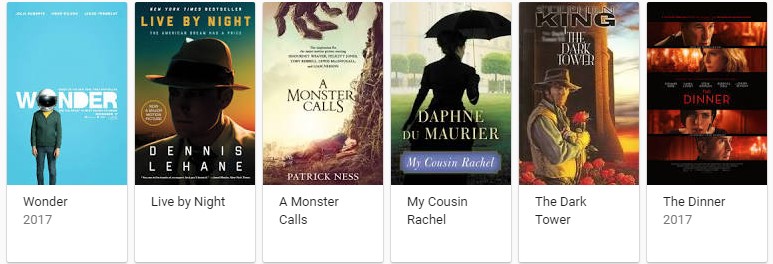
Similar to its affinity for sequels and remakes , it seems to me like Hollywood is increasingly looking to books for inspiration for the next blockbuster hits. From a business standpoint, it makes total sense because producers can draw on the popularity of a certain book and use that to their advantage when it comes to marketing the film’s release.
As an avid reader, I am always excited at the news that a book is being adapted as a feature film. My mind is occupied by thoughts of who the actors/actresses are going to be (and if I approve), if the film will stay true to the book, and most importantly, if the movie will be just as good as the book. The thought of finally being able to visualize what has only previously been limited to my imagination is always an exciting prospect.
However, I am usually underwhelmed after watching a certain film based on a book, and if you asked me a year ago which one I would prefer: the movie or the book, I would have immediately chosen the book.

Hands down. No doubt. However, within the past year, I have come to appreciate movie adaptations of books more because I have realized that comparing books to their counterpart movies isn’t fair; at the end of the day, the two mediums of storytelling have different advantages and different qualifications for what makes them good. Like Stephen King once said, comparing one to the other is like comparing apples to oranges. They are both great sources of entertainment, but they aren’t comparable. For those still reluctant to accept this theory, I’ll be delving more into this age-old question: “What’s better: books or movies?” I’ll make a case for each argument and let you make the final call.
The popular belief is that books are often a hundred times better than their movie counterparts; if you need any further proof, just take a look at the following Washington Post visual.
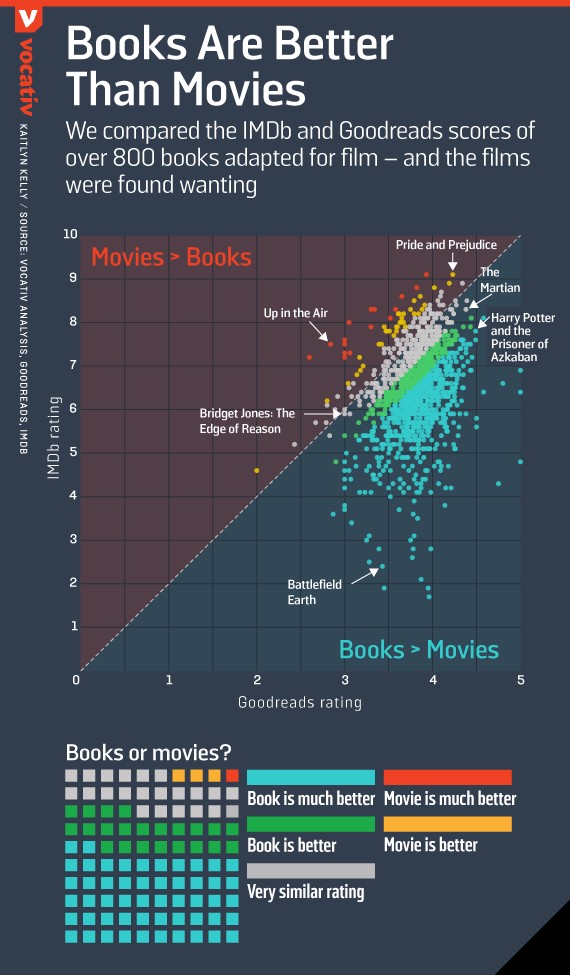
Books are great because they allow the reader to be a part of the story; we are the observers that have insight into the character’s thoughts and feelings, and all the nuances that create three-dimensional characters. With books, there’s just more. More detail, more focus on character development, and more depth to the meaning of the artwork. It’s also the more time-consuming form of the two, and after finishing a novel, after a couple of hours of being immersed into a different world and mind space, it seems like you have suddenly been thrust back into reality.
On the other hand, the great thing about movies is their ability to show, and the overall experience of watching one. While reading a book, I often have a movie reel playing in my head. I can map out the setting, I can see the characters’ expressions, and I can empathize with their emotions.
However, watching the same story unfold on the big screen is a different experience. While reading spurs your imagination, a movie helps you visualize all the elements of the books that were previously confined to your imagination. It immerses you into the story in a different way than a book.
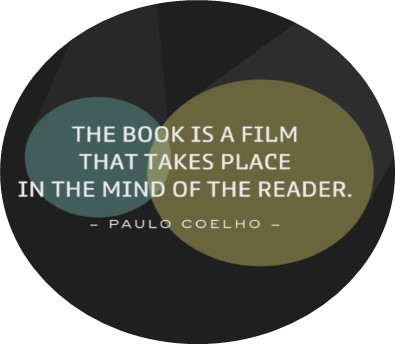
For example, instead of reading about the magical world of Harry Potter, while watching the movie, I can actually see what J.K. Rowling means by “He was almost twice as tall as a normal man and at least five times as wide. He looked simply too big to be allowed, and so wild – long tangles of bushy black hair and beard hid most of his face, he had hands the size of dustbin lids and his feet in their leather boots were like baby dolphins.” To put it simply, movies make it easier for us to just lean back and enjoy the show.
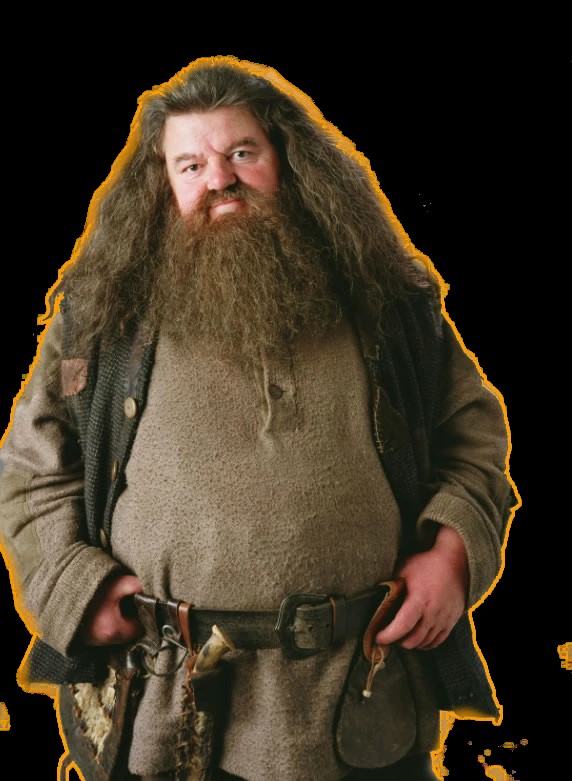
An added benefit of movies is the music and visual designs that enhance the experience of watching a film. Imagine, for example, that you are watching an emotional scene. It’s the climax of the story, and in the background plays a gentle orchestra, that eventually swells into a big crescendo as the story reaches its resolution. In that moment, you feel exactly what the characters feel, and your heart races along with the melody of the music. So although (in some cases) the audience might not have a play by play of the characters’ thoughts and emotions, movies have another way of conveying the emotion and tone of a certain scene.
If you feel like further exploring this age-old debate personally, come down to Media Services to check out movies even the worst critic would have to admit are just as good as the books. Don’t know where to start? Try Pride and Prejudice, Psycho, Jaws, The Godfather, etc.
Until next time! RE
Robiati Endashaw is a sophomore studying public policy analysis in KSB with a minor in Economics. In her spare time, she enjoys reading non-fiction and watching crime documentaries.

Robiati Endashaw offers a balanced perspective on the age-old debate between books and their movie adaptations. As an avid reader, she acknowledges the initial skepticism toward films based on beloved books. However, she also appreciates the unique advantages of both mediums of storytelling. While books allow for deeper immersion and detailed character development, movies excel in visual storytelling and immersive experiences. Endashaw emphasizes that comparing books and movies is like comparing apples to oranges; they serve different purposes and offer distinct pleasures. Her insights encourage readers to appreciate the merits of both forms of storytelling and explore adaptations with an open mind.
Oh gee thanks so much . I also feel quite the same way too when it comes to books as in they are so much enjoyable because they allow us as the reader to explore the depths of my imagination and every thing happening Is felt dearly. 😊
Leave a Reply
Your email address will not be published. Required fields are marked *
This site uses Akismet to reduce spam. Learn how your comment data is processed .
Social media
- Instagram for Herman B Wells Library
- Facebook for IU Libraries
Additional resources
Featured databases.
- Resource available to authorized IU Bloomington users (on or off campus) OneSearch@IU
- Resource available to authorized IU Bloomington users (on or off campus) Academic Search (EBSCO)
- Resource available to authorized IU Bloomington users (on or off campus) ERIC (EBSCO)
- Resource available to authorized IU Bloomington users (on or off campus) Nexis Uni
- Resource available without restriction HathiTrust Digital Library
- Databases A-Z
- Resource available to authorized IU Bloomington users (on or off campus) Google Scholar
- Resource available to authorized IU Bloomington users (on or off campus) JSTOR
- Resource available to authorized IU Bloomington users (on or off campus) Web of Science
- Resource available to authorized IU Bloomington users (on or off campus) Scopus
- Resource available to authorized IU Bloomington users (on or off campus) WorldCat
IU Libraries
- Diversity Resources
- About IU Libraries
- Alumni & Friends
- Departments & Staff
- Jobs & Libraries HR
- IU Libraries Blog
- Intranet (Staff)
- Login (Blogs admin)
Want to create or adapt books like this? Learn more about how Pressbooks supports open publishing practices.
55 Writing about the Novel: Film Comparison
You began the process of writing your literary comparison paper in the Introduction to the Novel chapter by choosing an essay, reading it carefully, and writing a personal response. In this chapter, we will move through the remaining steps of writing your paper.
Step 3: Choose a Film for Comparison
The key to a good comparison essay is to choose two subjects that connect in a meaningful way. The purpose of conducting the comparison is not to state the obvious, but rather to illuminate subtle differences or unexpected similarities.
When writing a film comparison paper, the point is to make an argument that will make your audience think about your topic in a new and interesting way. You might explore how the novel and the film present the theme…or how the novel and the film explore the identity of a main character…or…the options are limitless. Here’s a quick video giving you a little overview of what a film vs novel comparison might look like:
To this end, your next goal is to choose a film adaptation of your novel. Some novels may only have one, but some have many that have been created over the last 100 years! Your adaptation could be a feature film, a YouTube short, or an indie film. Choose one that allows you to make an interesting point about the portrayal of the theme of the novel and the film.
Step 4: Research
Once you’ve chosen a second piece, it’s time to enter into the academic conversation to see what others are saying about the authors and the pieces you’ve chosen.
Regardless of the focus of your essay, discovering more about the author of the text you’ve chosen can add to your understanding of the text and add depth to your argument. Author pages are located in the Literature Online ProQuest database. Here, you can find information about an author and his/her work, along with a list of recent articles written about the author. This is a wonderful starting point for your research.
The next step is to attempt to locate articles about the text and the film themselves. For novels, it’s important to narrow down your database choices to the Literature category. For essays, you might have better luck searching the whole ProQuest library with the ProQuest Research Library Article Databases or databases like Flipster that include publications like newspapers and magazines.
Finally, you might look for articles pertinent to an issue discussed in the novel. For example, The Grapes of Wrath is about the Great Depression and the Dust Bowl, but it also contains an environmental theme. Depending on what aspect you want to highlight in your comparison, you might look for articles about the Great Depression or about farming and the environment.
Remember, it is helpful to keep a Research Journal to track your research. Your journal should include, at a minimum, the correct MLA citation of the source, a brief summary of the article, and any quotes that stick out to you. A note about how you think the article adds to your understanding of the topic or might contribute to your project is a good addition, as well.
Step 5: Thesis & Outline
Similar to other academic essays, the film comparison essay starts with a thesis that clearly introduces the two subjects that are to be compared and the reason for doing so.
This video highlights some of the key differences between novels and films:
Begin by deciding on your basis for comparison. The basis of comparison could include items like a similar theme, differences in the focus of the piece, or the way both pieces represent an important issue.
This article gives some helpful advice on choosing a topic.
Once you’ve decided on the basis of comparison, you should focus on the points of comparison between the two pieces. For example, if you are focusing on how the literary elements and the cinematic elements used impact the message, you might make a table of each of these elements. Then, you’d find examples of each element from each piece. Remember, a comparison includes both similarities and differences.
By putting together your basis of comparison and your points of comparison, you’ll have a thesis that both makes an argument and gives readers a map of your essay.
A good thesis should be:
- Statement of Fact: “The novel and the film of Pride and Prejudice are similar in many ways.”
- Arguable: “The film version of Pride and Prejudice changes key moments in the text that alter the portrayal of the theme.”
- Personal Opinion: “‘The novel is definitely better than the movie.”
- Provable by the Texts: “Both the novel and the film focus on the importance of identity.”
- Obvious: “The movie provides a modern take on the novel.”
- Surprising: “Though the movie stays true to the original themes of the novel, the modern version may lead viewers to believe that the characters in the book held different values than are portrayed in the novel.”
- General: “Both the novel and the film highlight the plight of women.”
- Specific: “The novel and the film highlight the plight of women by focusing on specific experiences of the protagonist. “
The organizational structure you choose depends on the nature of the topic, your purpose, and your audience. You may organize compare-and-contrast essays in one of the following two ways:
- Block: Organize topics according to the subjects themselves, discussing the novel and then the film.
- Woven: Organize according to individual points, discussing both the novel and the film point by point.
Exercises: Create a Thesis and Outline
You’ll want to start by identifying the theme of both pieces and deciding how you want to tie them together. Then, you’ll want to think through the points of similarity and difference in the two pieces.
In two columns, write down the points that are similar and those that are different. Make sure to jot down quotes from the two pieces that illustrate these ideas.
Following the tips in this section, create a thesis and outline for your novel/film comparison paper.
Here’s a sample thesis and outline:
Step 6: Drafting Tips
Once you have a solid thesis and outline, it’s time to start drafting your essay. As in any academic essay, you’ll begin with an introduction. The introduction should include a hook that connects your readers to your topic. Then, you should introduce the topic. In this case, you will want to include the authors and title of the novel and the director and title of the film. Finally, your introduction should include your thesis. Remember, your thesis should be the last sentence of your introduction.
In a film comparison essay, you may want to follow your introduction with background on both pieces. Assume that your readers have at least heard of either the novel or the film, but that they might not have read the novel or watched the film–or both–…or maybe it’s been awhile. For example, if you were writing about Pride and Prejudice , you might include a brief introduction to Austen and her novel and an introduction to the version of the film you’ve chosen. The background section should be no more than two short paragraphs.
In the body of the paper, you’ll want to focus on supporting your argument. Regardless of the organizational scheme you choose, you’ll want to begin each paragraph with a topic sentence. This should be followed by the use of quotes from your two texts in support of your point. Remember to use the quote formula–always introduce and explain each quote and the relationship to your point! It’s very important that you address both literary pieces equally, balancing your argument. Finally, each paragraph should end with a wrap up sentence that tells readers the significance of the paragraph.
Here are some transition words that are helpful in tying points together:
Finally, your paper will end with a conclusion that brings home your argument and helps readers to understand the importance/significance of your essay.
In this video, an instructor explains step by step how to write an essay comparing two films. Though you will be writing about a novel and a film, rather than two films, the same information applies.
Here’s another instructor explaining how to write a comparison essay about two poems. Note the similarities between the two videos.
Here’s a sample paper:
Attributions:
- Content created by Dr. Karen Palmer. Licensed under CC BY NC SA .
- Content adapted from “Comparison and Contrast” from the book Successful Writing licensed CC BY NC SA .
The Worry Free Writer Copyright © 2020 by Dr. Karen Palmer is licensed under a Creative Commons Attribution-NonCommercial-ShareAlike 4.0 International License , except where otherwise noted.
Share This Book

- Character Traits
- Compare and Contrast
- Read Alouds
- Point of View
- Reading Response Ideas
- Summarizing
- Text Features
- Text Structures
- Find the Fib
- Reusable Ideas
- Disclosure Policy
- Lifetime Access
- 9 Low Prep Ideas
- Opinion Writing Prompts
- Student Gift Ideas
- Writing Ideas
- Party Ideas
- Countdown Ideas
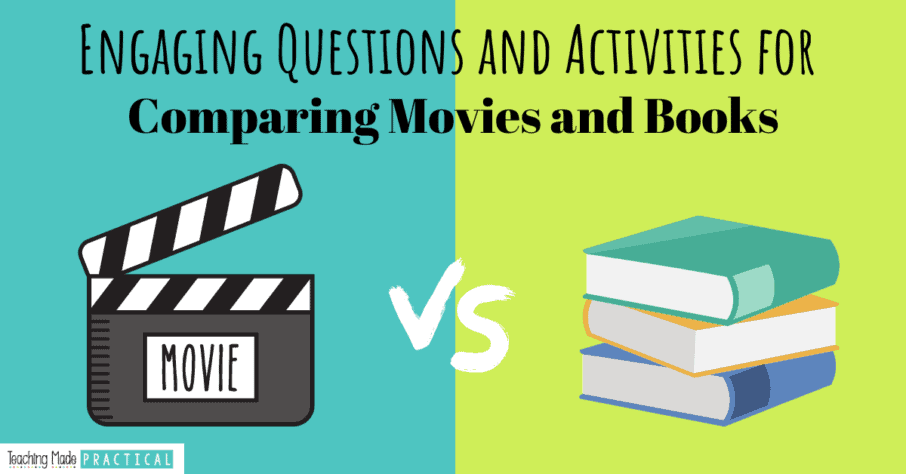
Compare and Contrast A Book and Movie Activities
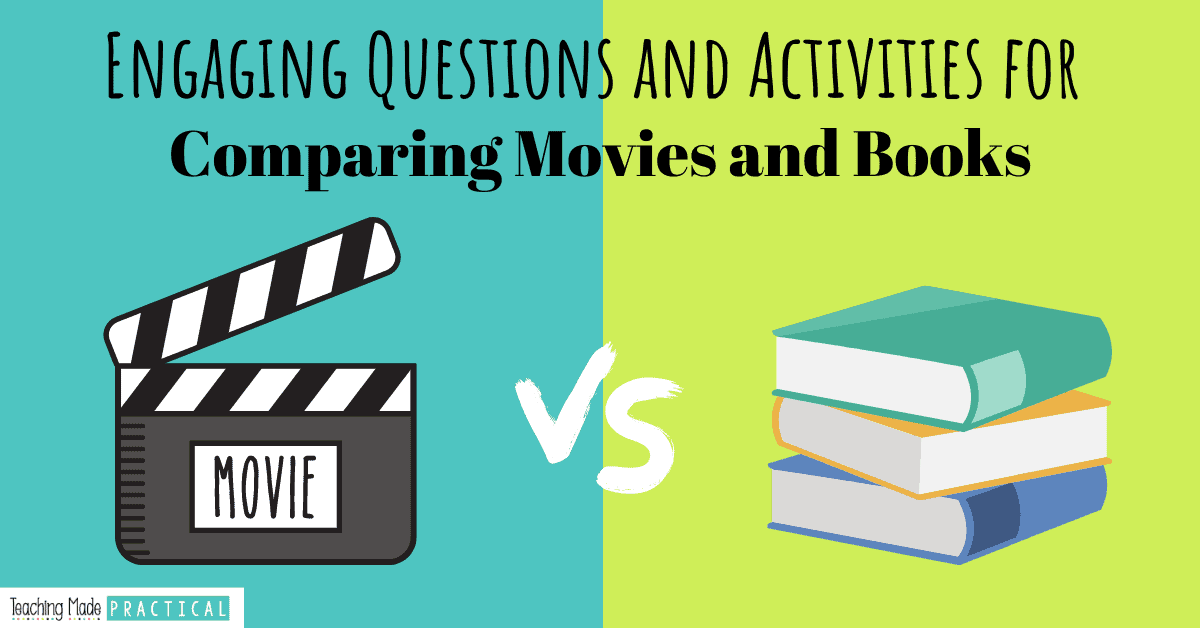
My first year teaching - when I was constantly running on empty - I slipped several movie watching afternoons into my lesson plans. I defended this as educational, claiming that we were going to compare and contrast the book and movie. Really, however, I just needed some time to play catch up.
Now, we did actually spend some time comparing and contrasting the book with the movie, but this was still a little bit of a cop-out. My students filled in a blank Book Vs. Movie Venn Diagram, and most of the similarities and differences they found were simply the first observations that came to their head. These were surface level observations that required no real thinking.
I wanted my students to think more critically and more deeply.
Comparing and contrasting a book and a movie can be a very meaningful, educational experience that requires critical thinking - and without all the prep. Use the questions and activity ideas below to help make your movie vs book lesson plans more rigorous for your 3rd, 4th, and 5th grade students.
Or, check out these ready to use, no prep activities for comparing books and movies.
Questions to Include in Your Movie Vs. Book Lesson Plans
I found the best way to encourage deeper thinking was to ask upper elementary students some questions before watching the movie so that they would be thinking more critically while watching the movie. This also helped my 3rd graders think about what they expected from the movie. (No duh - teachers use before, during, and after reading questions with books. For some reason it took me a while to translate that to movies.)
Then, after the movie, I encouraged my students to think about very specific details about the book and movie, rather than just comparing and contrasting using the first thing that popped into their heads.
Not all of the questions I asked were directly related to comparing and contrasting the book and the movie, but these questions got students thinking more critically, which made their comparisons later more thoughtful.
Use the example questions below in your own compare and contrast lesson plans. And while you're at it, teach students to ask their own meaningful questions.
Pre-Movie Questions
• What do you think your favorite part of the movie will be, and why? • What do you think the main characters will look like/act like? • What do you think the main setting will look like? Will it be messy, small, bright, noisy, beautiful, spooky, cold, colorful, etc? • What parts of the book do you think will be cut out of the movie? • What should be added to the movie to make it better than the book? • Which do you think you will enjoy more – the book or the movie? Why? • What was your favorite scene in the book? Would you be upset if this scene was changed in the movie? • What parts of the book will be difficult to portray in the movie? For example, how should the movie portray what a character is thinking?
Post-Movie Questions
• Which did you enjoy more – the book or the movie? Why? • Did the main characters look and act like you expected? Why or why not? • Did the main setting look like you expected? Why or why not? • Think about the scenes that the movie changed so that they were different from the book. What scenes do you wish hadn’t been changed? What scenes were better because of the change? • What parts of the book did the movie leave out? What scenes were added to the movie that weren’t in the book? Were these changes good or bad, and why? • What are some other differences between the book and the movie? • What stayed the same in both the book and the movie? • Whose point of view do you agree with more - the author of the book or the director of the movie? Why?
Want to hold students accountable while watching a movie? Check out this No Prep Movie Vs. Book Resource.
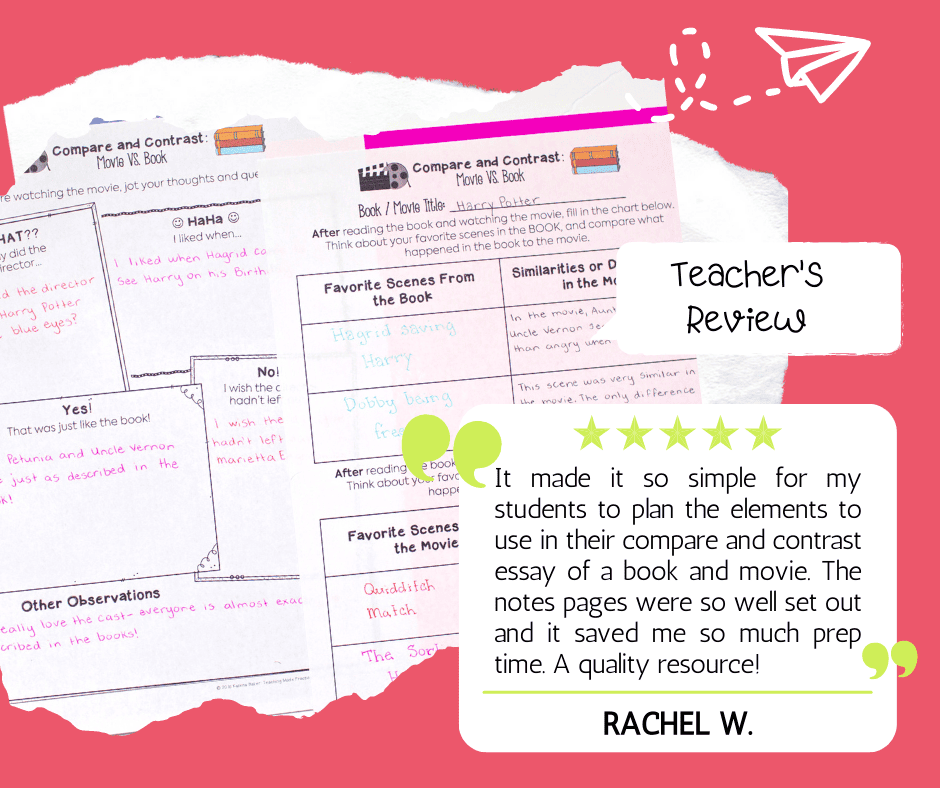
Activity Ideas to Compare and Contrast
Apart from asking questions, there several fun, yet rigorous activities you can do with your 3rd, 4th, and 5th grade students to help them compare and contrast the movie.
For example:
- Have students assign a grade to the movie based on how well it stayed true to the book, and then defend the grade.
- Have students write an essay comparing and contrasting the movie and the book.
- Have students write book reviews and movie reviews.
- Have partners or groups of students list as many differences they can find. See what group can find the most!
- Have students think about one of the scenes that wasn't included in the movie. Then, have them draw/write about what it would have looked like if the director would have included it.
- Have students use paragraph frames to write an opinion paper explaining which was better - the book or the movie.
Principal Problems?
Some principals look down on activities like this for upper elementary students, and understandably so. Too often, movies are used as a way to babysit students - however, this activity really can be meaningful.
This no prep resource is a great way to convince your principal that comparing and contrasting a book with its movie version can be rigorous. They will LOVE the scaffolded compare and contrast essay and other activities. Best of all, it can be used over and over again with ANY book that has a movie companion.
This is a great activity for the end of the year!

Books and Movies that can be Compared and Contrasted
Below is a list of children's books that are also movies. Before showing the movies to your class, be aware of your school's policy on movies. Some of these are rated PG or PG-13 and have some language and content that you might want to fast-forward through or that might require parental consent.
Because of Winn Dixie
- The Tale of Despereaux
- The Phantom Tollbooth
- Charlotte's Web
- Wizard of Oz
- Charlie and the Chocolate Factory
- James and the Giant Peach
- Cloudy With a Chance of Meatballs
- Mrs. Frisby and the Rats of NIMN
- Where the Red Fern Grows
- Polar Express (a great option for a fun Christmas activity )
- The Lion, the Witch, and the Wardrobe
- The Indian in the Cupboard
Where the Wild Things Are
- Fantastic Mr. Fox
- Spookley the Square Pumpkin
- How to Train Your Dragon
- A Wrinkle in Time
- Tuck Everlasting
- Percy Jackson Series
- Harry Potter Series (your students who love Harry Potter might like some of these similar books)
- The Mouse and the Motorcycle
- The Witches
City of Ember
- Escape from Mr. Lemoncello's Library
- Freak the Mighty
- Flora and Ulysses
- The Bad Guys
- Maniac Magee
Never Stress Over Sub Plans Again!

Make copies, find a fiction book, and you'll be ready for any emergency that comes your way!
Comments 178
I love to do Polar Express, Tuck Everlasting, Jumanji, The Wizard of Oz, and Charlotte’s Web (both the cartoon and regular one). I wish I could do them all in a year, but I have to pick a couple to do each year. I am doing a 4/5 split this year, so it will be harder to decide.
I love teaching Because of Winn Dixie!
I am currently teaching a Christmas carol to my 7th grade learning support students. We are going back and forth between reading the play and watching the movie. However, as far as our comparing and contrasting go, we are having more discussion than anything. This would be s fantastic resource that I could use with them right now!
Charlotte’s Web as it works great as a cross-curricular unit with life cycles in science.
My favorite novel to compare and contrast with the movie is “Hatchet”!
I love to compare and contrast The BFG. I feel that students often times enjoy the movie so much more after they have read and discussed the book. There are so many things in the book that are not in the movie and the students love to point them out.
Sarah, Plain and Tall…I’m from Kansas and I love this book because it reminds me of home and my grandparents farm. The movie was actually shot in Emporia, Kansas, where I attended college, and I actually waited on Christopher Walken at a restaurant I worked at at the time. 🙂 Great memories!
I like to compare Charles Dickens’ “A Christmas Carol” with Theodor Seuss Geisel’s “How the Grinch Stole Christmas”. Fingers crossed! Thanks for hosting this giveaway. Teresa Special Ed Shenanigans
Polar Express would be perfect!
Charlie and the Chocolate Factory is a good one! I also like doing Shiloh!
I loved comparing the first Harry Potter because my students loved the book and I was able to get permission to show the movie. I also do Because of Winn-Dixie and my students love that
I love to compare the movie and book: The Grinch Who Stole Christmas and The Polar Express
Wonder – It sparks great discussions and has so many great messages that benefit the students.
I just commented and realized that I hit submit too quickly. I meant to add that we like to compare Number the Stars to the Disney movie Miracle at Midnight. I accidentally mentioned the picture book The Butterfly. (Which is another great comparison)
Jumanji and Zathura, as well as Percy Jackson are all interesting to compare and contrast.
The Lion, the Witch and the Wardrobe
My class loves to compare Number the Stars with the picture book The Butterfly. We also enjoy reading Island of the Blue Dolphins and then watching/comparing it to the movie.
I would love the holes package as I am planning on reading that novel in the new year
My favorite book to read and compare with the movie is the Newberry Award-winning novel The Phantom Tollbooth… such amazing fun with words, maps, adventure, and learning important lessons. Truly a timeless treasure! 🙂
My students and I love Winn Dixie! We’ll be watching the movie soon.
The Witches by Roald Dahl
Holes is my favorite!
Inside Out, Mr. Magorium’s Wonder Emporium, or Sky High
I also love Matilda! Harry Potter is also a strong movie representation of the book. 🙂
Thank you so much!!
My 5th graders compare and contrast the book The Sign of the Beaver to its companion movie Keeping the Promise.
Cloudy With a Chance of Meatballs or Horton Hears a Who!
I am a first year teacher and my 4th grade students and I have just completed reading aloud all 17 Chapters of “Harry Potter and the Sorcerer’s Stone” – it has taken us the entire semester! I was able to get approval for us to the watch the movie the last day before winter break, and I could really use some compare/contrast activities to make the experience more meaningful (and to fill the afternoon when the movie is done!) Here’s hoping you choose a newbie to the profession! (Krista G., TMP member and 4th grade teacher in Johns Creek,GA)
We’re reading Fantastic Mr Fox at the moment, because the film is quite different it’s really interesting to see what the students can pick apart for an author’s intent and why it might be different.
Percy Jackson – The Lightning Thief! My kids love it!
I would love to compare/contrast The Giver. I haven’t seen the movie yet, but I love the book! 🙂 Thank you and happy holidays!
I am an absolute Wizard of Oz fanatic! I even had a “Toto” dog and named her Ruby, after the red slippers! I always wanted to to compare and contrast with the book and movie, but couldn’t find a resource where my admin. would allow me to do it. I also love Charlie and the Chocolate Factory as well! And of course WONDER!
We’ve done To Kill a Mockingbird. I would love to do Wonder.
The Polar Express!
Thank you for all you thorough work. In my 5th grade class, we read and watch War Horse. The film adaptation is a favorite among my students. They love comparing the book and movie to see the differences. One of most talked about differences is about Joey and Albert at the end. I will not say more and spoil it! Check it out!
My favorite book to compare to the movie is The Grinch. We do the animated and the Jim Carrey version. Now, there is a new movie. We could start comparing the movies to each other!
Wonder!!!! My class LOVES the book, and they are SO excited to watch the movie! They are very similar, but my kids were mad they left a few things out, and laugh at how different the characters looked compared to what they had imagined!
compare and contrast Mr. Popper’s Penguins
Freak the Mighty and Tuck Everlasting
I love teaching Charlotte’s Web! Comparing and contrasting is one of my favorite things to do with this!
Any Narnia book with the movie version.
Tale of Desperaux and Percy Jackson and the Lightening Thief.
I like to use compare and contrast of the movie and the book with either The Polar Express or Charlie and the Chocolate Factory. I use the old version of this movie and book rather than the Johnny Depp version which is almost identical to the book.
I’m a huge Roald Dahl fan and do at leats two of his books a year. My favourites for compare and contrast book to movie are The BFG and Charlie and the Chocolate factory. This is more about content and missed bits than plot change.
Another good one is The Tale of Despereaux – the movie is so sanitised and happified (is that a word?!) compared to the darker, and in my opinion better, book – more opportunity for critical thinking.
Winn Dixie!
Our school is showing The Polar Express to families as a fun evening activity next week. I would love to read my students the book and compare and contrast the movie and book:-)
Thanks for the awesome free resources!!!
I would love to compare “The Hate You Give!” with my class.
Wonder would be a great book/movie to compare and contrast!
Holes would be great!
We love comparing and contrasting both Where the Red Fern Grows, To Kill a Mockingbird a Mockingbird and Old Man and the Sea. I would love to do the same with Freak the Mighty or The Giver!
I love any Ronald Dahl book. Currently, we are doing BFG. Next is Matilda! 🙂
The City of Ember has been a fun one to compare movie and book. I would love to teach Because of Winn Dixie, since Kate DiCamillo is one of my favorite writers.
Swindle. I do it as a read aloud at the beginning of school, then we watch the movie.
To Kill a Mockingbird book and movie
Tuck Everlasting is a good one!
Phantom Tollbooth is one of my favorites and has been since I was younger. Although I think it’s a little too high for my current students.
Wonder is a favorite of mine.
I did Polar Express last week, and we are going to do It’s A Wonderful Life/ The Great Experience next week! 🙂
I love Holes for my 5th grade babies.
The Grinch, and The Lorax are my favorite. I am interested in looking into comparing Tale of Despeaurex
I love reading Because of Winn Dixie and we are going to watch the movie this year too! I also love the Polar Express!! I would love use your resources please!
We are just finishing Wonder and will watch the movie in a couple of weeks.
Our grade level loves to compare and contrast “The Polar Express.” We do a whole week centered around this book, then wrap up the week with a Polar Express party and the movie. Then we complete a graphic organizer to compare and contrast both of them, and write a short essay response.
Wonder! We are going to start reading that after Christmas break!
I love Because of Winn Dixie!
I love to use Harry Potter and the Sorcerer’s Stone or Chamber of Secrets with upper elementary because I’m a huge HP nerd. They take a long time to read though!
Charlotte’s Web
Right now we are reading Harry Potter (the 1st one). We will be watching the movie version to compare and contrast. 🙂
I’ve done The Grinch with classes multiple times, I was excited to do Stubby the War Dog last spring unitl I realized the movie wasn’t out yet!
Harry Potter is a fun compare and contrast.
The Worst/ Best Christmas Pageant Ever!
The Lion, the Witch and the Wardrobe!
I want to do Ferdinand this year with my Dual Language students!
Sarah, Plain and Tall (and the series)
I use Shiloh.
Wonder. Or any Harry Potter
I’ve done Charlie and the chocolate factory as well as Charlotte’s Web. Love the activity 🙂
I love comparing and contrasting Holes.
This is such a fun activity! I’d like to try the Nutcracker, once the new movie comes out, or use an older version. I’d love to see if there is a movie for Hatchet. The Indian in the Cupboard would be fun!
We read “The Best Christmas Pageant Ever” as a class novel every year in December and then watch the movie.
I have compared and contrasted Cloudy with a chance of Meatballs many times, but I would like to compare and contrast Matilda.
I like to compare/contrast Charlotte’s Web.
I like to compare/contrast “Series of Unfortunate Events”. My 4th graders love that book. We use the old movie with Jim Carey, and now with the Netflix version they are able to view it at home and come up with yet another take on the story.
Stone Fox or Polar Express!
I love comparing and contrasting the Polar Express or the Grinch with my 4th grade students.
I love to use Charlotte’s Web and Wonder.
I love your resources! I look forward to and enjoy the freebies you send! They are greatly appreciated. I would like to compare/contrast Wonder. I am currently reading the book to my students. Thank you! 🙂
I read Stelluna to my class every year, but I didn’t realize there was a movie too! I am definitely going to have to get the movie so we can compare and contrast the book vs movie. Thanks for the idea!
I love to compare and contrast The Grinch and The Lorax.
We usually compare and contrast Maniac Magee. The book is amazing, but the movie leaves out SO much of the story! Great one to prove the book is much better.
Wonder and Phantom Tollbooth
I love to compare and contrast the book/movie Wonder. Both the book and the movie are wonderful and my students enjoy both. I am doing Tuck Everlasting and The Giver this year as well.
We compare and contrast the movie The Best Christmas Pageant Ever, Maniac Magee, and Charlie and the Chocolate Factory. My kids love finding ways the movie is different. Many of them have also promised me they will create a movie for There’s a Boy in the Girls’ Bathroom when they grow up. It is one of our favorites! 🙂
I love comparing and contrasting Because of Winn-Dixie with my students
Charlotte’s Web is fun to compare and contrast! There’s several different versions of movies to choose from – animated and non-animated.
I just started reading Because of Winn-Dixie with a fifth grader and he already saw the movie, so your compare/contrast resource is very helpful! Thank you
Each year I compare/contrast The Christmas Shoes just before Winter break. I also did Wonder last year.
I love to compare and contrast Wonder with my fifth graders!
When I taught third grade I would compare and contrast Charlie and the Chocolate Factory and Charlotte’s Web. With my sixth graders, we compare and contrast Where the Red Fern Grows.
I love to do the movie/book comparison for HOOT. There are a lot of differences and it is a popular book with both the boys and the girls.
Book to movie– Matilda
I think The Grinch would be a great one!
The grinch is a movie and book I would like to compare/contrast
I would like to compare/contrast Wonder. Thanks for all of your resources.
I would like to compare and contrast The Best Christmas Pageant Ever! 🙂
We ha e read the Tale of Despereaux and I’d love to compare/contrast that story with the movie.
I love Charlotte’s Web!
I love compare and contrasting The Outsiders with my 6th graders, but this year I’m embarking on a new one – Percy Jackson and the Olympians – The Lightning Thief. The students are so jazzed about finishing the book and looking forward to watching the movie!!
My class reads Wizard of Oz every year. Of course, we also watch the movie. It’s the best compare & contrast! Although we did do Because if Winn Dixie last year too, because it was a Battle of Books. 😉
This is perfect! We are working on comparing and contrasting and getting ready to do Polar Express. Awesome! Choose me, choose me
Thanks for all of your resources you provide. I am interested in compare/contrast for the movie Polar Express! Thanks
This time of year I like to “How the Grinch Stole Christmas” as a compare and contrast of the book versus the movie. It has such a nice message.
Book/Movie to compare/contrast: The Grinch!!
I love doing Stuart Little! 🙂
Love Love love Charlotte’s Web to compare and contrast.
I love to compare and contrast Stone Fox with my fourth graders.
I have been comparing and contrasting movies for years. The last few years it has been harder to find the time because some administrators do not feel that showing a movie is educational. Last year I showed the movie Holes after having read the book with my fourth graders. I think I will go back to my all time favorite this year, Peter Pan (the cartoon). Many of my students have not heard of the great Disney classic movies yet alone read one.
My team teacher and I are hoping to compare and contrast the book/movie of Wonder this year in fourth grade!
I would love to use this with Wonder. 🙂
Actually, my team and I are planning to compare and contrast the Polar Express! Thank you!
Some of the book/movies I’ve done:
Hachiko Waits vs. Hachi: A Dog’s Tale Sarah, Plain & Tall Holes
Jumanji & Zathura
I have compared the books and movies for Polar Express and The BFG.
We do Wonder and we compare and contrast the book and movie! Lots of fun!
My favorite movie & book to compare & contrast is Stone Fox. There are a ton of differences between the 2 so it’s very easy to contrast for sure!
My students and I have been reading Escape from Mr Lemoncello’s Library and I just learned there is a series/movie! I’d love to use your resources!
Percy Jackson, The Lightning Thief by Rick Riordan. We love the book.
We used Winn Dixie this year, which was a hit. We also did this last year with Wonder. We read it aloud to start the year and watched it towards the end to have a full circle ending! I’d love to try the Polar Express around this time of year as well.
I love to use Mr. Popper’s Penguins to compare and contrast a book and a movie. There students have to really listen and focus to find the similarities in the two. They always love how many differences there are and are very quick to point them out…so much so that they can hardly watch the movie for telling each other and me things like, “Hey! They didn’t do that in the book.” or “That’s not anything like how Mr. Popper acted in the book.” I love to see that they are paying attention to those details, and it helps me know how well they listened to the book as we read it in class. I would love to have additional resources to use in my classroom to make my book/movie comparison lessons more engaging. Thank you for the opportunity, and thank you for all that you do and share with educators.
I love to compare and contrast The Sign of The Beaver. It’s old but every year the students love it. The movie is different enough that it gives lots of opportunities for discussions.
I would like to try to compare and contrast the book and movie versions of Stellaluna.
I am comparing and contrasting The Westing Game book and movie the week before Christmas.
The Grinch would be great for my fourth graders!
I want to compare and contrast Because of Winn Dixie with my students!
Because of Winn Dixie and Polar Express
Holes for sure is my favorite! What a great resource.
I would love to compare and contrast the book and movie Polar Express!
The Grinch Who Stole Christmas
We have compared and contrasted the book and movie “Holes”! I also like to do “Charlotte’s Web”.
I also love reading Matilda! So many themes you can pull from that text. Around this time of year, we like to read The Grinch, discuss it in depth, then watch the classic version of the movie. Inadvertently, we are also able to make comparisons with the more recent version of The Grinch and compare both adaptations with the book.
My students and I are finishing Charlie and the chocolates factory! I would love to put this great spin on watching the movie. #12daysofChristmas
I would love any of the books/movies listed above. Especially Polar Express! One of my favorites! Thanks for everything!
I love Polar Express of course! But earlier this year we did Stone Fox with my third graders and that was so fun! They loved finding all the little differences!
Where the red fern grows is an excellent comparison but watching the movie students can really feel the emotion which in the book they may not understand some of the events that take place
My favorite book/movie to compare and contrast is “Bridge to Terabithia” by Katherine Paterson. The students get to compare and contrast events that happen in the book and not in the movie (or vice versa), but an added bonus is they get to compare and contrast the visual that they create in their minds of imaginary world Terabithia and the magical world the producers made. There are lot of points to compare that it always leads to a great discussion!
We love to compare any Roald Dahl books/movies.
My third graders have been reading Charlie and the Chocolate Factory, and they have been loving it!! We will be finishing it next week, so the following week (right before break) we will be watching the movie! I was already planning on having my students compare and contrast the movie to the book, so this resources would definitely be a huge help!!
I would like to compare the book/movie Wonder with my kiddos.
My favorite book and movie to compare and contrast is Harry Potter and the Sorcerer’s Stone. My 5th graders love it!
A unit my students are doing focuses on the Nez Perce Indian tribe. We read the book, Thunder Rolling in the Mountains, and then watch the movie, I Will Cry No More Forever. I have my students do some comparing/contrasting, but I would love your resources! Thank you!
The first book we read is Mrs Frisby and the Rays of NIMH. We then compare and contrast it with the movie, the Rats of Nimh. This time of year we read A Christmas Carol together and then watch A Muppet Christmas Carol and compare. It’s a bit silly, but so fun for the last week before Christmas break. I also hope to use The Man Who Invented Christmas and do a little compare and contrast with Dickens actual life.
So I would love to compare and contrast Harry Potter, but it is such a taboo book and I don’t know that I’d even want to try it. I would also love Matilda! I’ve never thought of that one, but I saw it on the list as I was scrolling through, and thought it would sound fun!
I would love to compare and contrast “The Polar Express” movie and book. Not only is it perfect to read around the holidays, but we are actually working on comparing and contrasting right now. It is a perfect way to do something fun and interesting with the kids that will also be educational and get them in the holiday spirit.
Charlie and the Chocolate Factory is the latest book/movie we have done this with. Back when the first Harry Potter movie came out, we did that one and it was a HUGE hit. There were so many points to compare and contrast in that set! The kids loved it!!! One student told me that reading the book was like a movie playing is his head, because the details were so well written in the book. I think I may need to recycle that one. 🙂
Thank you! Have a great day!
I am reading Because of Winn-Dixie for the first time with a class. I would love to have the movie to show them when we finish right before winter break.
I am currently reading Tale of Depereaux with my four sections of language arts classes. I would love to have some resources to help my students compare and contrast the book to the movie!
Thank you, Ms. G Heiligenstein
My latest favorite movie/book to compare/contrast is Wonder.
I just compared and contrasted The Jungle Book movie and story and then we got to watch a play of it too. The kids loved it!
I would love to compare/contrast the book and movie “Wonder” with my students. Such good themes and point of view!!
I would love to be able to compare and contrast the book and movie “Wonder”.
My all time favorite read aloud and movie to watch with my kids is Holes! I read this book as a kid probably 5 or 6 times. I love being able to share my love for this book and the movie. 🙂 It’s great for 5th and 6th grade students.
I love comparing Balto to the movie. The real story to the cartoon. I would love to have this resource to use during this unit. Happy Holidays. Debbie
My students are a little older than yours but good materials are good materials. We are currently doing 2 different book/movie projects (the students had a choice.) We are doing Wonder and The Hate U Give.
I use The Lion, The Witch, and the Wardrobe and The Giver with my middle school students.
I’ve been receiving your newsletter for some time now. Perhaps I originally requested your sub plans, but if so I’m afraid I’ve mislaid them. Now when I click on the button to request them, nothing happens.
Could you please send me your sub plans, maybe via email?
I emailed them to you!
My class always enjoys “Lemoney Snickett: A Series of Unfortunate Events.”
Leave a Reply Cancel reply
You must be logged in to post a comment.
Cover to Cover: Comparing Books to Movies
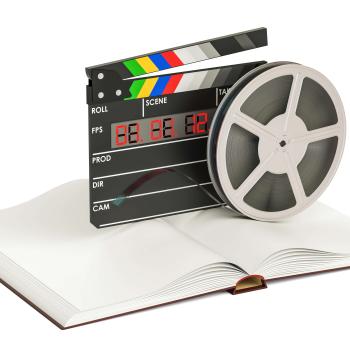
- Resources & Preparation
- Instructional Plan
- Related Resources
Movies can be an integral part of the language arts classroom when they are used in ways that encourage and develop students' critical thinking. In this activity, students explore matching texts—novels and the movies adapted from them—to develop their analytical strategies. They use graphic organizers to draw comparisons between the two texts and hypothesize about the effect of adaptation. They analyze the differences between the two versions by citing specific adaptations in the film version, indicating the effect of each adaptation on the story, and deciding if they felt the change had a positive effect on the overall story. Students then design new DVD covers and a related insert for the movies, reflecting their response to the movie version.
Featured Resources
- Grades 6–8 Book and Film List : This text list includes books and their corresponding movies that are appropriate for the middle school classroom.
- DVD Cover Creator : This online tool allows users to type and illustrate CD and DVD covers and related booklets for liner notes and other information.
From Theory to Practice
Movies have long been a part of the educational setting, but they can take on the role as simple entertainment unless teachers develop lessons that ask students to move beyond seeing the film as "just entertainment." Renee Hobbs explains that "When we use film and television in the classroom, it is important to do so in ways that promote active, critical thinking" (48). Hobbs urges teachers to design activities that "engage and motivate reluctant readers, enabling them to build comprehension strategies" (45). As students compare novels and the related film adaptations in this lesson plan, they move beyond simple entertainment to the kind of deeper critical thinking Hobbs advocates. Further Reading
Common Core Standards
This resource has been aligned to the Common Core State Standards for states in which they have been adopted. If a state does not appear in the drop-down, CCSS alignments are forthcoming.
State Standards
This lesson has been aligned to standards in the following states. If a state does not appear in the drop-down, standard alignments are not currently available for that state.
NCTE/IRA National Standards for the English Language Arts
- 1. Students read a wide range of print and nonprint texts to build an understanding of texts, of themselves, and of the cultures of the United States and the world; to acquire new information; to respond to the needs and demands of society and the workplace; and for personal fulfillment. Among these texts are fiction and nonfiction, classic and contemporary works.
- 3. Students apply a wide range of strategies to comprehend, interpret, evaluate, and appreciate texts. They draw on their prior experience, their interactions with other readers and writers, their knowledge of word meaning and of other texts, their word identification strategies, and their understanding of textual features (e.g., sound-letter correspondence, sentence structure, context, graphics).
- 5. Students employ a wide range of strategies as they write and use different writing process elements appropriately to communicate with different audiences for a variety of purposes.
- 6. Students apply knowledge of language structure, language conventions (e.g., spelling and punctuation), media techniques, figurative language, and genre to create, critique, and discuss print and nonprint texts.
- 8. Students use a variety of technological and information resources (e.g., libraries, databases, computer networks, video) to gather and synthesize information and to create and communicate knowledge.
- 11. Students participate as knowledgeable, reflective, creative, and critical members of a variety of literacy communities.
- 12. Students use spoken, written, and visual language to accomplish their own purposes (e.g., for learning, enjoyment, persuasion, and the exchange of information).
Materials and Technology
- Grades 6–8 Book and Film List
- Book(s) and film you plan to share with students
- Television and VCR or DVD player
- Writer’s Notebook
- Permission to View Film/Video handout
- Focused Reading and Viewing Guide
- Book and Movie Comparison/Contrast Guide
- Thinking Critically about the Movie Adaptations: Preferences and Effects
- DVD Cover Templates and Layout
- Movie Adaptation DVD Cover and Notes Project
- Movie Adaptation DVD Cover and Booklet Project Rubric
- A Closer Look at Book and DVD Covers (optional)
Preparation
- Select a book that has been made into a movie to read aloud to the class. Possible titles have been included on the Grades 6–8 Book and Film List . If you wish to make these activities cross-curricular then cross-check the title with the Website Teach with Movies .
- Obtain permission for viewing the film using the Permission to View Film/Video handout, or the permission forms and any other documents required by your school or district.
- Decide whether students will complete the Focused Reading and Viewing Guide as they read or after the novel is complete.
- Share the novel with the class.
- Make copies of all necessary handouts.
- Test the DVD Cover Creator on your computers to familiarize yourself with the tool and ensure that you have the Flash plug-in installed. You can download the plug-in from the technical support page.
Student Objectives
Students will
- identify the characters, setting, plot, and resolution in a book and in the movie based upon the book.
- describe how the elements of the book and movie are alike and different.
- discuss the effects of and state preferences toward these similarities and differences.
- hypothesize reasons that movie makers altered characteristics from the book.
- design a DVD cover and booklet reflecting their response to the movie adaptation.
Session One
- After the book has been completed, ask the students to think about a time when they read a book and then saw a movie based upon that book.
- Ask students to recall the kinds of things that they thought about as they watched the movie. Students will respond with ideas that suggest they were comparing the book to the movie and mentally noting similarities and differences.
- Inform students that since they have just finished the book, they are going to watch a movie based upon it. During the movie they will consider how well the movie honors the ideas presented in the book.
- Have students fill in the book column on the Focused Reading and Viewing Guide , working individually or in small groups.
- Review items in the book column of the Focused Reading and Viewing Guide as a class, and ask students to watch for these elements during the movie.
- Explain when students will complete the film section of the Focused Reading and Viewing Guide —while watching the movie or after. Students’ ability to attend to multiple tasks should be a factor in making your decision.
- Begin viewing the film.
Session Two
- Review the previous session’s viewing.
- See if students have any questions or concerns regarding the film section of the Focused Reading and Viewing Guide .
- Continue viewing the film.
Session Three
- After viewing the film, go over students’ responses to the film section of the Focused Reading and Viewing Guide .
- Pass out copies of the Book and Movie Comparison/Contrast Guide , which asks them to determine how different elements of the story are alike and different, and ask students to complete the guide in pairs or small groups.
- Have students share their observations with the class.
- As a closure activity, ask students to share why they think some of the elements are different and whether it is important for movies to remain identical to the novels on which they are based.
Session Four
- Explain that students will be create a new DVD cover for the movie adaptation the class has viewed.
- To prepare for the task, review the Book and Movie Comparison/Contrast Guide .
- Using the handout as a guide, ask students, independently or in small groups, to discuss the changes they like most and least as well as the aspects of the film that remained true to the text that were most satisfying. If necessary, reference A Basic Glossary of Film Terms for appropriate cinematic terminology.
- Pass out copies of the Thinking Critically about a Movie Adaptation: Preferences and Effects handout.
- Have students determine one change or similarity that was crucial to their overall opinion of the film, and discuss it in the first row.
- Ask students to choose two elements of moderate importance to discuss in the middle rows.
- Have students indicate and discuss a fairly inconsequential change in the last row.
- As students complete the charts, collect them for informal feedback, focusing on comments that will help students strengthen their analytical skills.
- If students need additional time, this work can be completed on their own before the next session.
Session Five
- Return Thinking Critically about a Movie Adaptation: Preferences and Effects handouts, and share any general comments on students’ work.
- Have students or groups share their ranked responses to the film adaptation.
- Encourage engagement from other students, as there should be varying views at many levels at this point: Some students will think a change was significant, but was an improvement. Other students will see the same change as trivial, but feel it was a poor choice.
- Distribute the Movie Adaptation DVD Cover and Notes Project and DVD Cover Project Rubric to students and discuss the options for the project and related expectations.
- If possible, preview the DVD Cover Creator interactive on a projector so students understand their choices for templates in both Cover and Booklet modes. If this is not possible, distribute copies of the DVD Cover Creator Templates and Layout .
- Allow students time to plan the front cover, spine, and back cover. They should plan for a mix of images and text that will suit the needs of the project they choose.
- Allow students time to plan the text for their booklet. Responses should be brief, as the DVD Cover Creator interactive can hold approximately 50 lines of text (if no images are used). Guide students to connect their overall impressions of the film adaptation with the choices they made on their covers.
- If students need additional guidance in writing the review of the movie, see ReadWriteThink lesson So What Do You Think? Writing a Review . Students may also use the Internet Movie Database as needed to find information about the movie.
Session Six
- Take students to the computer lab and lead them in a brief demonstration of the DVD Cover Creator interactive if not completed in the previous session.
- Have students use their planning documents to transfer their ideas to the DVD Cover Creator interactive.
- Emphasize that tudents cannot save their work, so they should complete all work on one component (the cover or booklet) and print their work within the confines of a session.
- Gauge levels of completion and allow additional time in the computer lab if necessary.
Session Seven
- Have students share their responses through presentations or by setting up a display of the various projects around the room.
- Allow students to reflect on their work and the work of their classmates by quickwriting on the different perspectives offered in the DVD covers presented today.
- Facilitate a “Point/Counterpoint” debate between the students who preferred the book to the movie and vice versa.
- Have students create an alternate soundtrack to the film, justifying their choices in liner notes and creating a CD cover with the CD Cover Creator .
- In Session 5, have students analyze book and DVD cover art using the A Closer Look at Book and DVD Covers handout. Guide students to explore elements such as placement of text and what words are featured or downplayed; color choices; choice of images; placement of images; and the like.
Student Assessment / Reflections
- Collect students’ graphic organizers, and check for evidence of students’ understanding of story elements.
- During discussion, look for comments that show students can think critically about why movies and books would not be identical and that communicate their preferences for the film or book.
- For a formal assessment of group performances, use the DVD Cover Project Rubric .
- Calendar Activities
- Student Interactives
Students compare the film versions of The Lord of the Rings and Tolkien's novels. Students then imagine how a scene in a current novel that they are reading would be filmed.
The CD/DVD Cover Creator allows users to type and illustrate CD and DVD covers and related booklets for liner notes and other information. Students can use the tool to create covers for books, music, and films that they explored as well as to create covers for media they compose individually or as a class.
- Print this resource
Explore Resources by Grade
- Kindergarten K

To Watch or to Read: The Great Debate of Books vs. Movies
The debate between books vs. movies has been raging for decades. Some people prefer the immersive experience of reading a good book, while others enjoy the visual and auditory spectacle of a blockbuster movie. While both mediums have their own unique advantages and disadvantages, there is no denying that they both offer a powerful and engaging way to tell a story.
In this article, we will explore the pros and cons of both books and movies and delve into the reasons why some people prefer one medium over the other. We will also examine the impact that film adaptations have had on the literary world, and how books and movies have influenced and inspired each other over the years.
Through this exploration, we hope to provide a better understanding of the book vs. movie debate and help readers decide which medium they prefer. Whether you’re a die-hard bookworm or a film buff, there’s no denying that both books and movies have a place in our cultural landscape. So sit back, relax, and join us as we explore the great debate of book vs. movie.
Book Vs Movie: Compare And Contrast
Books vs. movies: The age-old debate. Here’s a chart summarizing the key differences between books and movies:
These are just a few of the many differences between books and movies, and there is no right or wrong choice when it comes to deciding which medium you prefer. It ultimately comes down to personal preference and what you enjoy most in a story.
The Advantages of Reading a Book Over Watching a Movie
Books and movies are two very different forms of media. While movies can be visually stunning and entertaining, books offer a deeper, more immersive experience that simply can’t be replicated on the big screen. In this section, we’ll explore some of the key advantages of reading a book over watching a movie and find out the reasons why good books are better than movies.
Reading a book offers a more immersive experience than a movie, as it allows readers to delve deeper into the story and form a stronger connection to the characters. With more extensive descriptions of people, places, and events, readers can visualize the story in their own way and bring their own experiences and perspectives to the reading experience. This personal connection is not possible with a movie, which visualizes the story for the viewer.
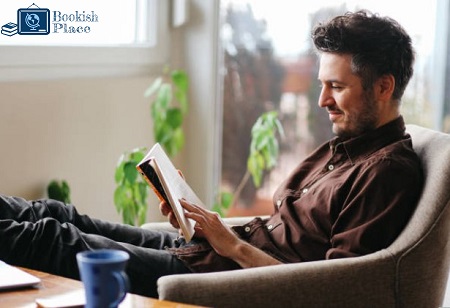
Reading also has cognitive benefits, improving memory, focus, and concentration, as readers actively process and make connections between story elements. Additionally, reading expands vocabulary and language skills, exposing readers to a wider range of words and sentence structures.
While movies have their own unique advantages, such as a cinematic experience and visual and auditory stimulation, reading a book offers a deeper, more engaging experience that cannot be matched by any other medium. Overall, the benefits of reading make it an essential and highly rewarding activity.
The Advantages of Watching a Movie Over Reading a Book
While there are numerous advantages to reading a book, there are also many reasons why watching a movie can be a more enjoyable and fulfilling experience. In this section, we’ll explore some of the key advantages of watching a movie over reading a book and find out the reasons why movies are better than books.
Movies have a distinct advantage over books due to their visual medium, which can create stunning visuals, deliver visceral impacts, and transport viewers to different worlds. Movies are also more convenient than books, as they require less time and effort to enjoy. Additionally, movies are accessible to a broader audience, including young children and those with limited literacy skills.
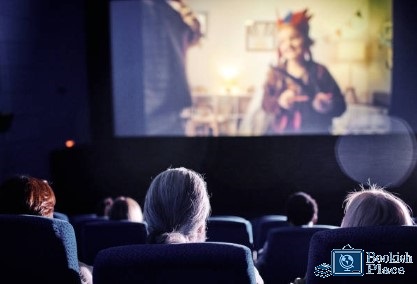
Finally, movies offer a shared experience that can bond friends and family and create lasting memories. While books offer a deeper, more immersive experience and can improve cognitive functioning and language skills, movies should not be overlooked. Movies are an essential and valuable part of our culture, and their unique advantages should be appreciated.
The Importance of Originality: The Book vs. Movie Debate
The importance of originality is a crucial factor in the debate of book vs. movie. Books and movies require originality to stand out in their respective mediums.
In books, originality is crucial to the success of the story, as readers are looking for something new and fresh. Authors who can deliver original and compelling stories are more likely to attract a loyal following of readers.
On the other hand, movies need to offer something unique and different from what has come before to succeed in a crowded marketplace. Audiences want to be entertained and challenged, to see something they haven’t seen before. The challenge lies in adapting a book for the screen, as movies need to capture the essence of the original story while also offering something new and original to viewers. A successful movie adaptation captures the spirit of the original story while also offering something fresh and unique to the audience.
Overall, originality is crucial for both books and movies to be successful and memorable.

The Impact of Film Adaptations on Book Sales
Film adaptations of books have become common in the entertainment industry, and their impact on book sales is significant. A successful movie adaptation can result in a surge of book sales and increased attention for the author. However, a poorly received adaptation can damage the reputation of the source material and turn potential readers away.
The impact of film adaptations on book sales can also vary depending on the genre of the book , with young adult novels having a particularly strong impact. A successful adaptation can also lead to increased interest in the author and their other works.

Nonetheless, the relationship between books and movies is complex, and a delicate balance must be struck between staying true to the source material and offering something new and original.
Despite the challenges, it is clear that the relationship between books and movies is important, with each medium having the potential to influence and enhance the other.
Comparing the Popularity of Books and Movies: A Statistical Analysis
This section explores the popularity of books and movies by analyzing sales figures and audience engagement.
According to the Association of American Publishers, book sales in the US reached $25.8 billion in 2020, while global box office revenue for movies was $42.2 billion in 2019. However, these figures are not necessarily indicative of overall popularity, as the success of a book or movie can depend on various factors such as genre and marketing.
In terms of audience engagement, a survey by the Pew Research Center found that 65% of American adults reported reading a book in print or digital format in 2019, while data from the Motion Picture Association shows that the average US moviegoer attended about 5 movies in theaters in 2019 .
Nonetheless, it is important to note that reading books and watching movies are not mutually exclusive activities, and personal preference and taste play a significant role in determining the popularity of these two forms of entertainment.
Ultimately, both books and movies have the potential to provide enjoyable and meaningful experiences for viewers and readers alike.
Why Some Movies Fail to Capture the Essence of the Book
Movie adaptations of books often face challenges in capturing the essence of the original work. The biggest challenge is condensing the story into a shorter running time, which can result in a movie that feels rushed or incomplete, with important plot points or character development left out.

Another challenge is finding the right tone and style, as books can be written in a variety of styles, from lyrical and poetic to straightforward and simple. Filmmakers may make changes to the story or characters that alter the tone or style of the original work, resulting in a movie that feels different from the book. Inner thoughts and emotions, which are extensively described in books, can be difficult to convey visually, leading to clunky or awkward voiceovers or other techniques.
Lastly, some movies fail to capture the essence of the book simply because they are not faithful to the original work, as filmmakers may make changes that are not in line with the author’s vision.
Overall, adapting a book to a movie is a challenging task that requires balancing various elements such as condensing the story, finding the right tone, conveying inner experiences, and staying faithful to the original work. However, when done well, a movie adaptation can provide a fresh perspective on a beloved story and introduce new audiences to the world of the book.
How Movies Can Enhance or Detract from the Reading Experience
Movies can impact the experience of reading books in both positive and negative ways. While a well-made movie adaptation can bring a story to life in a new way and provide new insights into the characters and settings, it can also limit your imagination and leave out important details or changes that affect the overall meaning of the story
A movie adaptation can enhance the reading experience by providing a visual representation of the story and bringing new nuances to the characters and events. On the other hand, movies can detract from the reading experience by limiting the reader’s imagination and leaving out important details or changing aspects of the story that affect its overall meaning. When a movie adaptation leaves out a key subplot or character, the story may feel incomplete, and if it changes the ending of the story, it can alter the entire meaning of the book.
Ultimately, the decision to read a book or watch a movie adaptation is a personal one and depends on the individual’s preferences and the specific book and movie in question.
Does Reading the Book First Ruin the Movie Experience?
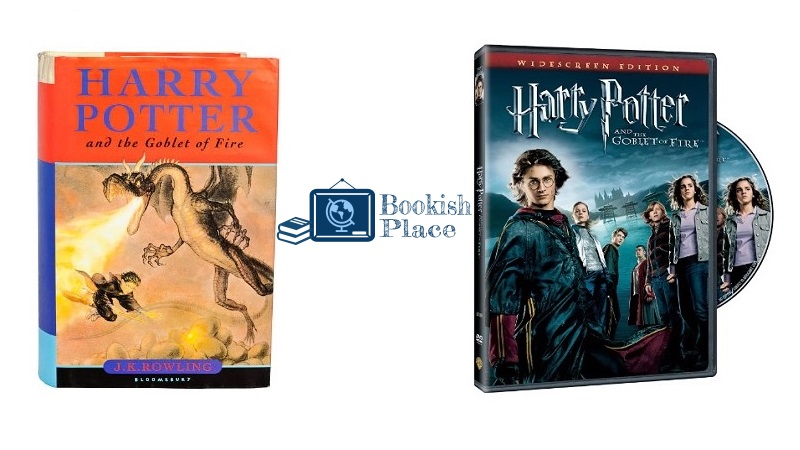
The debate over whether reading the book before watching the movie adaptation ruins the movie experience has been ongoing. Some people believe that knowing the story beforehand takes away the suspense and surprises that make movies enjoyable, while others argue that reading the book first enhances the movie experience.
Those against reading the book first argue that it takes away from the suspense and surprise of the movie and leads to constant comparison with the book. However, reading the book first can also provide a deeper understanding of the story and characters, making the story more meaningful and impactful. It can also help fill in gaps that are often left out in the movie adaptation. Movies have to condense the story, leaving out important details or subplots, which can leave viewers feeling confused or unsatisfied.
Ultimately, whether reading the book first ruins the movie experience is a matter of personal preference. It’s up to the individual to decide whether they want to read the book first or wait to see the movie without any prior knowledge of the story.
The Role of Directors and Screenwriters in Adapting Books for Film
Adapting a book into a film is a challenging task that requires a skilled director and screenwriter to bring the story to life on the big screen. They must carefully decide which elements of the book should be included in the movie, considering the pacing, structure, characters, and motivations, to ensure that the movie stays true to the spirit of the book while also being entertaining for moviegoers. Without understanding the psychology of movie watchers, a movie hardly gets success at the box office. The tone and mood of the book must also be captured in the movie adaptation, which can be particularly challenging when adapting books known for their unique style or voice.
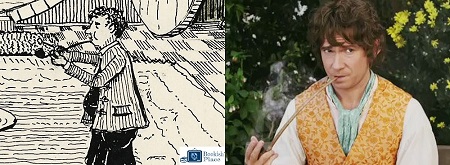
Practical constraints of the movie medium must also be considered, such as deciding which scenes and characters can realistically be portrayed on screen and which elements of the story may need to be altered or omitted to fit within the constraints of the movie format.
The success of a movie adaptation depends on the skill and creativity of the director and screenwriter, who must work together to craft a cinematic experience that stays true to the book while also being engaging for moviegoers. When done well, a movie adaptation can bring a beloved book to life in a new and exciting way, creating a powerful and memorable cinematic experience.
The Future of Books and Movies: Will One Outlast the Other?
The future of books and movies is uncertain, and it is difficult to predict which medium will outlast the other.
Books have been around for centuries and provide an immersive experience, allowing readers to engage with the story and characters. They have a wide range of genres and subject matter, making them accessible to a broad audience. On the other hand, movies offer a unique cinematic experience that cannot be replicated by any other medium. They visually immerse viewers in the story and characters and can reach a wider audience through mass distribution in theaters and online streaming platforms.
However, concerns remain about the future of both mediums. The rise of e-books and audiobooks and the decline of traditional print books are concerns for the book industry, while the decline of movie theaters and the rise of streaming services are affecting the movie industry.
Despite these concerns, both books and movies have shown resilience over time. While the formats may change, the desire for stories and entertainment will always be present. It is likely that both mediums will coexist in the future, with each offering its unique benefits to audiences.
The debate between books and movies will continue as both have their unique advantages and disadvantages, and the choice depends on personal preference. While books provide an immersive experience and movies offer a unique cinematic experience, the impact of movie adaptations on book sales and the role of directors and screenwriters in the adaptation process is crucial. Both books and movies have influenced and inspired each other, but some movies fail to capture the essence of the book.
Ultimately, both mediums have a place in our cultural landscape, and it’s important to celebrate and appreciate their unique benefits while enjoying the stories and characters they bring to life.
So, Keep Watching and Be Bookish !

Dennis K. Hawkins is a writer, blogger, book critic and bookish person. He has written several books and regularly write blogs. As a bookish, he reads a lot and regularly share his opinion regarding books. Besides, he has a huge collection of unique accessories related to book. So, he is an expert and also a real user of the book accessories that he chooses to write on.
Similar Posts
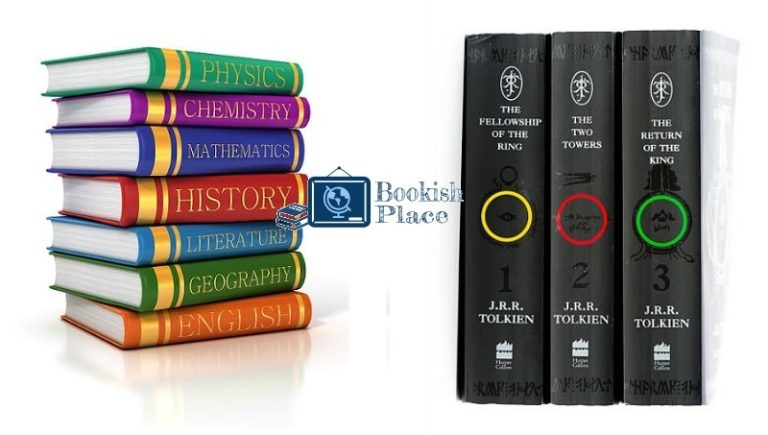
Book Versus Novel: Understanding the Important Differences and Similarities
Book versus novel is a vital topic that everyone should know. Books and novels are two terms that are often used interchangeably, but they have distinct differences. A book can refer to any written material that is bound together, while a novel is a specific type of book that is typically fictional and focuses on…
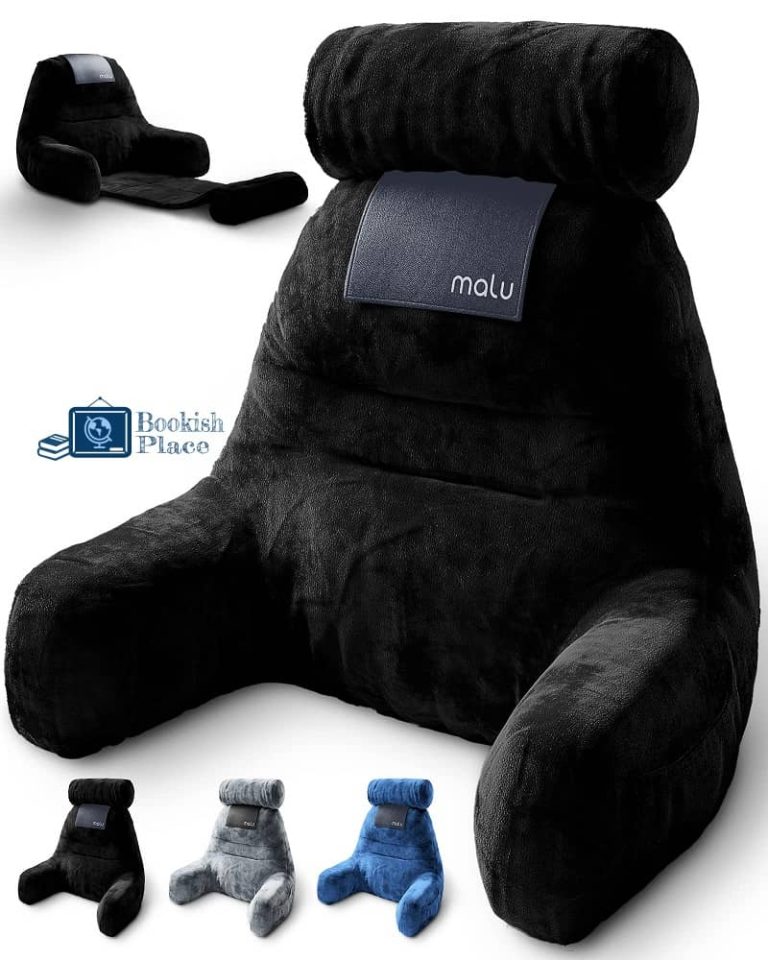
Are Reading Pillows Good for Your Back: Important Benefits of Reading Pillows
Are Reading Pillows Good for Your Back? Well, we all know how important it is to have good posture and take care of our spine. But sometimes, when we’re engrossed in a good book, it’s hard to maintain that perfect posture. That’s where reading pillows come in! Reading pillows are designed to support your back…
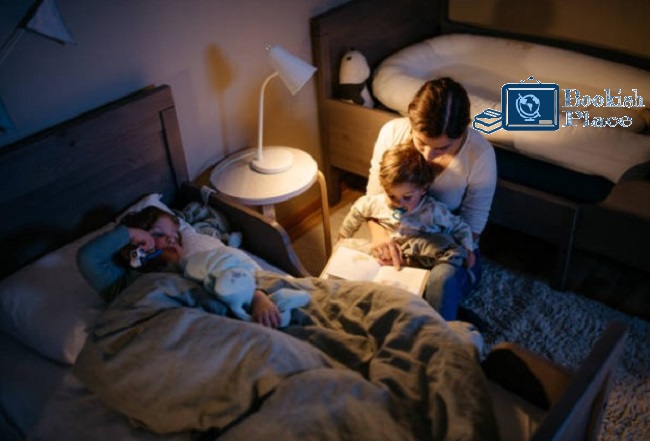
How to Read Books at Night Without Light: Important Tips for Bookish!
Do you love reading books but find it difficult to read at night without light? If so, then this blog post is for you! Here are some tips on how to read books at night without light! Bookish people love to read books at night while having no other sound. It helps concentrate on reading,…

How to Wash Reading Pillow: Important Issues You Need to Know!
If you have a reading pillow that you love, you want to keep it clean so that you can enjoy using it for years to come. Here is how to wash reading pillow. The article is a great solution to your all queries regarding how to wash reading pillow. You may notice that all pillows…
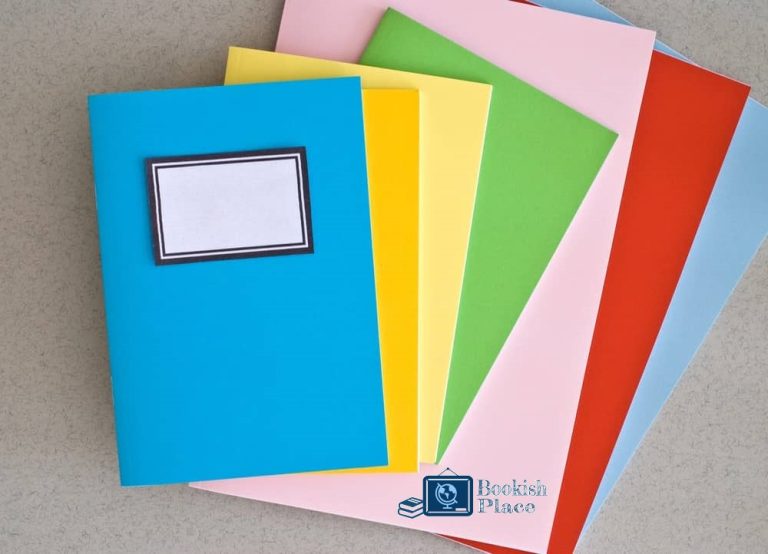
How to Cover Notebooks with Colored Paper Easily
How to cover notebooks with colored paper is an important know how by which you can beautify your notebook and give an elegant look to your desk or shelf. It also reflects how cool you are thus getting noticed by people. Notebooks have always been an important element in our daily life, whether you are…
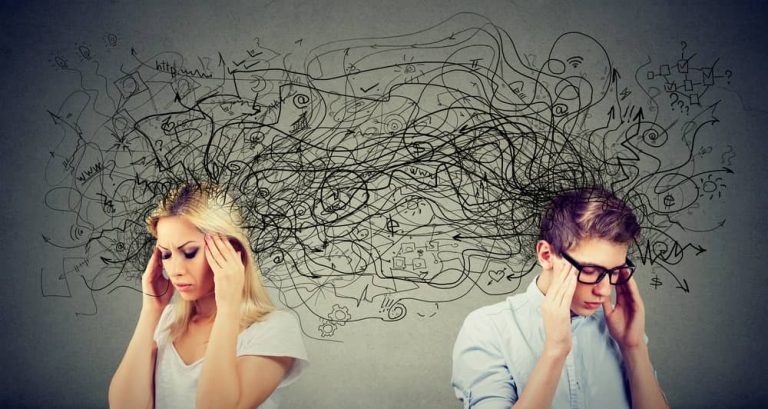
How To Telepathically Communicate With Someone
How to telepathically communicate with someone amazes many people. A lot of people make fun of telepathy, but it is true. Telepathy frequently happens between close friends. They often sense the other person’s feelings due to their entangled vibrations and cells. People who have been married for many years tend to experience this most frequently….
Leave a Reply Cancel reply
Your email address will not be published. Required fields are marked *
Save my name, email, and website in this browser for the next time I comment.
- Entertainment
- Environment
- Information Science and Technology
- Social Issues
Home Essay Samples Literature Pride and Prejudice
"Pride and Prejudice": Comparing the Book vs the Movie
Table of contents, character depth and development, narrative structure and pacing, visual and cinematic elements, interpreting themes and messages.
- Austen, J. (1813). Pride and Prejudice. London: T. Egerton.
- Thompson, E. (Director). (1995). Pride and Prejudice [Motion Picture]. United Kingdom: BBC Films.
- Wright, J. (Director). (2005). Pride & Prejudice [Motion Picture]. United Kingdom: Working Title Films.
- Johnson, C. (2010). Jane Austen on Screen. Cambridge University Press.
- Moor, A., & Warley, L. (2018). Adapting Jane Austen's Novels to Film. Palgrave Macmillan.
*minimum deadline
Cite this Essay
To export a reference to this article please select a referencing style below

- The Importance of Being Earnest
- The Waste Land
- The Color Purple
- Songs of Innocence and of Experience
- William Faulkner
- The Strange Case of Dr. Jekyll and Mr. Hyde
Related Essays
Need writing help?
You can always rely on us no matter what type of paper you need
*No hidden charges
100% Unique Essays
Absolutely Confidential
Money Back Guarantee
By clicking “Send Essay”, you agree to our Terms of service and Privacy statement. We will occasionally send you account related emails
You can also get a UNIQUE essay on this or any other topic
Thank you! We’ll contact you as soon as possible.
Beowulf: Comparing the Movie and the Book
The story of Beowulf has remained a significant work for centuries not only because it is one of our first lengthy works of English, but also because of the timelessness of the themes it contains and its applicability to a modern audience, regardless of the period in which ‘modern’ is denoted. One of the major themes of the story still applicable today is the concept of honorable courage, doing the right thing for the benefit of the many even though it may mean the sacrifice of the self.
This theme is particularly brought out when Beowulf faces the dragon toward the end of the saga. Comparing this scene as it appears in the ancient poem with its portrayal in the recent film Beowulf released in 2007 reveals that while there are some significant changes made to the action as the literature is brought into a filmic context, this same theme of self-sacrifice for the greater good remains a central element. By comparing the film and the book, similarities between the two stories can be traced as well as differences which can then be analyzed as to how each strives to make this theme evident.
In both the book and the film, Beowulf’s encounter with the dragon begins with the removal of a golden cup from his hoard. While this is an unidentified and otherwise meaningless cup accidentally removed by a peasant in the book, the return of a profoundly significant cup in the film helps to establish a connection between the earlier battles with Grendel and his mother and the upcoming battle with the dragon.
In each case, Beowulf goes to face the dragon with a group of men but arrives at the dragon’s lair with only a single helper, a young kinsman in the book, and an aging friend in the film. Many of the key events of the actual battle between dragon and man remain the same as well. Beowulf is driven off by flame, is failed by his sword, and must then attack using little more than a stabbing knife. Beowulf is burned horribly by the dragon’s fire as he attempts to kill it and knows of the dragon’s certain death before he dies himself of the wounds received during the battle.
However, in the book, Beowulf is assisted in killing the dragon by his second, the young kinsman Wiglaf, without whom he would have lost the fight leaving the dragon free to continue terrorizing the people. In an attempt to encourage his other warriors to assist him in helping Beowulf, Wiglaf tells the other men, “I had far rather that the flame should enfold my flesh-frame there alongside my gold-giver – as God knows of me.
To bear our shields back to our homes would seem unfitting to me unless first, we have been able to kill the foe and defend the life of the prince of the Weather-Geats” (2650-2656). Rather than running as all of the other thanes had done, Wiglaf boldly stands beside Beowulf and rushes in to defend Beowulf when the dragon manages to get him between his jaws. In the actions of Wiglaf, the Beowulf poet demonstrates the necessity for courageous men to go out and defend the public who may or may not even know what was put at stake for the individual in doing so. Because the dragon is killed and Beowulf remains alive long enough to see the dead carcass, Wiglaf is granted kingship over Beowulf’s lands as the only man willing to stand and defend them from whatever may attack.
The film does not provide Beowulf with this helpful younger man at his side in his moment of near-failure. The epic battle between Beowulf and the dragon takes place primarily in the air, with Beowulf clinging to the dragon’s hide with the help of a sword plunged deep into the skin of the beast but otherwise causing it little damage. As a result, Wiglaf, having aged as much as his leader, can do little to help but gallop after the flying dragon and save the two women important enough to Beowulf to cut off his own arm in order to reach the dragon’s heart and kill it. In his headlong and harrowing attempt to catch up with Beowulf and the dragon, Wiglaf does demonstrate the same kind of unfailing loyalty to his lord demonstrated in the book, but Beowulf himself provides the lesson regarding honorable courage. Although he is now old, he has learned the lesson Hrothgar did not. In failing to provide the water demon with a new young hero to seduce, Beowulf dies with the hope that the wiser Wiglaf might prevail against her. He knows he is going to his death in attempting to fight the dragon, but he faces the challenge with a steady heart, knowing he is working for the greater good of his kingdom. The film ends with the water demon attempting to seduce Wiglaf, who involuntarily steps into the water but retains his suspicious glance.
While the film has managed to change the epic battle between the dragon and Beowulf to a great deal, it does so as a means of addressing one of the most glaring holes in the poem, which is a connection between the early battles of Beowulf’s younger days with his tremendous battle at the end of the poem.
In attempting to communicate with a more sophisticated and worldly audience, the filmmakers provided enough difference and depth in their few amendments to convey the same sense of courage in the face of death that was conveyed to earlier audiences who did not require the same degree of intrigue and continuity as today’s media-saturated crowd.
Works Cited
Beowulf. Michael Alexander (Trans.). New York: Penguin Classics, 1973.
Cite this paper
- Chicago (N-B)
- Chicago (A-D)
StudyCorgi. (2021, September 24). Beowulf: Comparing the Movie and the Book. https://studycorgi.com/beowulf-comparing-the-movie-and-the-book/
"Beowulf: Comparing the Movie and the Book." StudyCorgi , 24 Sept. 2021, studycorgi.com/beowulf-comparing-the-movie-and-the-book/.
StudyCorgi . (2021) 'Beowulf: Comparing the Movie and the Book'. 24 September.
1. StudyCorgi . "Beowulf: Comparing the Movie and the Book." September 24, 2021. https://studycorgi.com/beowulf-comparing-the-movie-and-the-book/.
Bibliography
StudyCorgi . "Beowulf: Comparing the Movie and the Book." September 24, 2021. https://studycorgi.com/beowulf-comparing-the-movie-and-the-book/.
StudyCorgi . 2021. "Beowulf: Comparing the Movie and the Book." September 24, 2021. https://studycorgi.com/beowulf-comparing-the-movie-and-the-book/.
This paper, “Beowulf: Comparing the Movie and the Book”, was written and voluntary submitted to our free essay database by a straight-A student. Please ensure you properly reference the paper if you're using it to write your assignment.
Before publication, the StudyCorgi editorial team proofread and checked the paper to make sure it meets the highest standards in terms of grammar, punctuation, style, fact accuracy, copyright issues, and inclusive language. Last updated: November 13, 2023 .
If you are the author of this paper and no longer wish to have it published on StudyCorgi, request the removal . Please use the “ Donate your paper ” form to submit an essay.
by Laurie Halse Anderson
Speak speak, the book vs. speak, the movie, about the movie.
Speak the film was produced independently and released in 2004. Film production occured over a period of only 21 days in Columbus, Ohio. Anderson visited the set during filiming and appears in one scene as a lunchlady serving potatos. The film stars Kristen Stewart as Melinda, Eric Lively as Andy Evans , Allison Siko as Heather , and Hallee Hirsh as Rachel .The movie's tagline was "The Truth Will Change Everything."
Top 10 Differences Between the Book and the Movie
1) The movie takes place in the Midwest, not in Syracuse, New York.
2) The mascot only changes once in the movie, from Trojan to Hornet.
3) Melinda meets Heather on the school bus in the movie, not in the cafeteria.
4) In the movie, Melinda is raped in Andy's car, not outside of the party.
5) When Melinda is struck by mashed potatos in the movie, it is portrayed as purposeful, instead of accidental.
6) Mr. Neck and David Petrakis only argue once in the film, and David does not hire a lawyer
7) In the film Melinda cuts class only once and goes straight to the hospital.
8)Melinda does not send Rachel a warning note in the film. Instead, she only approaches her in person.
9) Andy does not attempt to rape Melinda a second time in the film. He just physically assaults her.
10) In the film, Melinda's final confession is to her mother, not to Mr. Freeman .
Laurie Halse Anderson on The Film
"The movie is very faithful to the book, but obviously, some things had to be cut. If they had filmed the whole book, it would have been a twelve-hour movie."
"I was on the set for a couple days, with my oldest daughter, Stephanie. It was a very moving, fun experience for both of us. The cast and crew were sweet, though I found that whenever Mr. Neck walked in the room, my stomach started to hurt."
"One unknown actress gave a stunning, if brief, performance in her role as The Lunch Lady Who Puts Mashed Potatoes on the Plate. Yes, folks, that was me."
"I love the movie. A lot. Jessica did a fantastic job. She had a budget of one million dollars....one camera, and three weeks to make the movie...The air conditioning in the building had to be turned off because the noise messed up the sound recording. A record-breaking thunderstorm opened up holes in the school's roof--over the room that held all the electrical boxes--and they lost power for a day. I have no idea how Jessica pulled it off, but she did."

Speak Questions and Answers
The Question and Answer section for Speak is a great resource to ask questions, find answers, and discuss the novel.
What aspect of The Scarlet Letter does Hairwoman seem obsessed with?
Hairwoman is obsessed with the symbolism in The Scarlet Letter.
How is Mr. Freeman keeping track of grades in his art class?
Mr. Frreman doesn't give grades, but rather, evaluates his students' work and paints his evaluations in a list on the wall.
what problems are people having with mr.freemans assignment? what advice does he give to help them? from pages 20-26
Mr. Freeman's assignment is rather abstract. He wants students to pick an object that metaphorically speaks to the person who views it. I think Mr. Freeman tells them to listen to themselves.
Study Guide for Speak
Speak study guide contains a biography of Laurie Halse Anderson, literature essays, quiz questions, major themes, characters, and a full summary and analysis.
- About Speak
- Speak Summary
- Character List
Essays for Speak
Speak essays are academic essays for citation. These papers were written primarily by students and provide critical analysis of Speak by Laurie Halse Anderson.
- The Power of Words: A Speak Analysis
- From Wishbones to Wings: The Symbolism of Birds in "Speak"
- The Factors That Helped Melinda Recover
- Sexual Assault in Speak
Lesson Plan for Speak
- About the Author
- Study Objectives
- Common Core Standards
- Introduction to Speak
- Relationship to Other Books
- Bringing in Technology
- Notes to the Teacher
- Related Links
- Speak Bibliography
Wikipedia Entries for Speak
- Introduction
- Literature and film
- Organizations
Home — Essay Samples — Literature — The Great Gatsby — “The Great Gatsby”: Comparison of The Movie and The Book
"The Great Gatsby": Comparison of The Movie and The Book
- Categories: Film Analysis The Great Gatsby
About this sample

Words: 745 |
Published: Dec 16, 2021
Words: 745 | Pages: 2 | 4 min read
Works Cited:
- Furuhata, Y. (2011). Beyond Boundaries: Genre, Narrative, and the Liminal Experience in Miyazaki's Spirited Away. Journal of Japanese and Korean Cinema , 3(1), 23-39.
- Lissauer, G. (2015). The Name Game: Spirited Away and the Power of Identity. In A. McMurray & R. Barton Palmer (Eds.), Dreams Rewired: Romanticism , Modernism, and the Cinema of Dreams (pp. 157-173). Amsterdam University Press.
- Matsunaga, K. (2010). Miyazaki's Spirited Away: Film of the Fantastic and Evolving Japanese Folk Symbols. Journal of Religion and Film, 14(2), 1-20.
- Penney, M. (2009). Spirited Away and the Conventions of Japanese Coming-of-Age Narratives. Japanese Studies, 29(2), 239-249.
- Rosenberg, A. (2014). Spirited Away and the Art of Surrender. The Washington Post. https://www.washingtonpost.com/news/act-four/wp/2014/06/30/spirited-away-and-the-art-of-surrender/
- Shingler, A. (2018). Spirited Away: An Interpretation of Its Symbolism. Mythlore, 36(2), 153-168.
- Stroud, S. R. (2013). Good and Evil in Miyazaki's Spirited Away. In M. J. Valdivia (Ed.), The International Handbook of Children, Media, and Culture (pp. 281-298). John Wiley & Sons.

Cite this Essay
Let us write you an essay from scratch
- 450+ experts on 30 subjects ready to help
- Custom essay delivered in as few as 3 hours
Get high-quality help

Dr Jacklynne
Verified writer
- Expert in: Entertainment Literature

+ 120 experts online
By clicking “Check Writers’ Offers”, you agree to our terms of service and privacy policy . We’ll occasionally send you promo and account related email
No need to pay just yet!
Related Essays
3 pages / 1144 words
2 pages / 863 words
2 pages / 992 words
4 pages / 1725 words
Remember! This is just a sample.
You can get your custom paper by one of our expert writers.
121 writers online
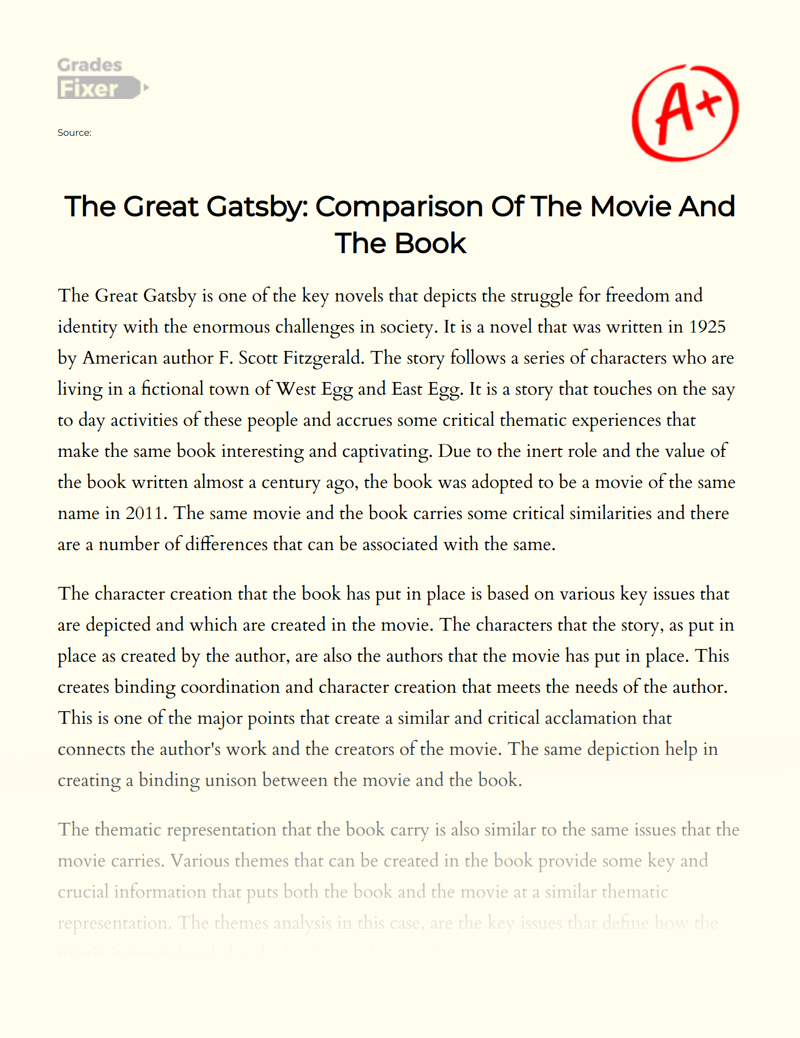
Still can’t find what you need?
Browse our vast selection of original essay samples, each expertly formatted and styled
Related Essays on The Great Gatsby
In the 1920s people were blind to see that life isn’t all about parting and spending money. By using wealth they seek to be seen. Sometimes people are so ignorant they ignore what’s right in front of them. The character’s [...]
Fitzgerald, F. Scott. 'The Great Gatsby.' Scribner, 1925.
F. Scott Fitzgerald's novel, The Great Gatsby, delves into the concept of the American Dream and its portrayal in 1920s America. The American Dream, a central theme in American literature, represents the ideal that every [...]
The Great Gatsby is a classic book from American Literature, written by F. Scott Fitzgerald, one of the greatest writers of the 20th century. Fitzgerald is said to be known for his descriptive language and he brings the roaring [...]
Definition of the American Dream F. Scott Fitzgerald's portrayal of the American Dream in "The Great Gatsby" Gatsby's desire to be accepted in the elitist "old money" society Gatsby's infatuation with Daisy [...]
Related Topics
By clicking “Send”, you agree to our Terms of service and Privacy statement . We will occasionally send you account related emails.
Where do you want us to send this sample?
By clicking “Continue”, you agree to our terms of service and privacy policy.
Be careful. This essay is not unique
This essay was donated by a student and is likely to have been used and submitted before
Download this Sample
Free samples may contain mistakes and not unique parts
Sorry, we could not paraphrase this essay. Our professional writers can rewrite it and get you a unique paper.
Please check your inbox.
We can write you a custom essay that will follow your exact instructions and meet the deadlines. Let's fix your grades together!
Get Your Personalized Essay in 3 Hours or Less!
We use cookies to personalyze your web-site experience. By continuing we’ll assume you board with our cookie policy .
- Instructions Followed To The Letter
- Deadlines Met At Every Stage
- Unique And Plagiarism Free
- My Storyboards
Comparing Book to Film: The Boy in the Striped Pajamas
In this activity, activity overview, template and class instructions, more storyboard that activities.
- This Activity is Part of Many Teacher Guides

After both reading the book The Boy in the Striped Pajamas and watching the movie, students should be able to identify many similarities and differences. While reading, students can often let their imaginations create the characters and settings. When viewing a movie that has been based off of a book, the characters or settings may seem different than what the reader imagined them to be. When students both read and watch a production of the same story, it can be interesting to see their different reactions.
With that in mind, have students read the entire book. Then, show them the movie adaptation. Once they have read and watched, have them create a comparison chart like the one above.
Examples of Differences
(These instructions are completely customizable. After clicking "Copy Activity", update the instructions on the Edit Tab of the assignment.)
Student Instructions
Create a storyboard comparing and contrasting the book and film. Be sure to highlight key changes or similarities.
- Click "Start Assignment".
- Identify key similarities and differences between the book and movie in the title boxes.
- In the first row, describe how that element is portrayed in the book.
- In the second row, describe how the element is portrayed in the film.
- Create an illustration for each cell using appropriate scenes, characters, and items.
- Click "Save & Exit" when done.
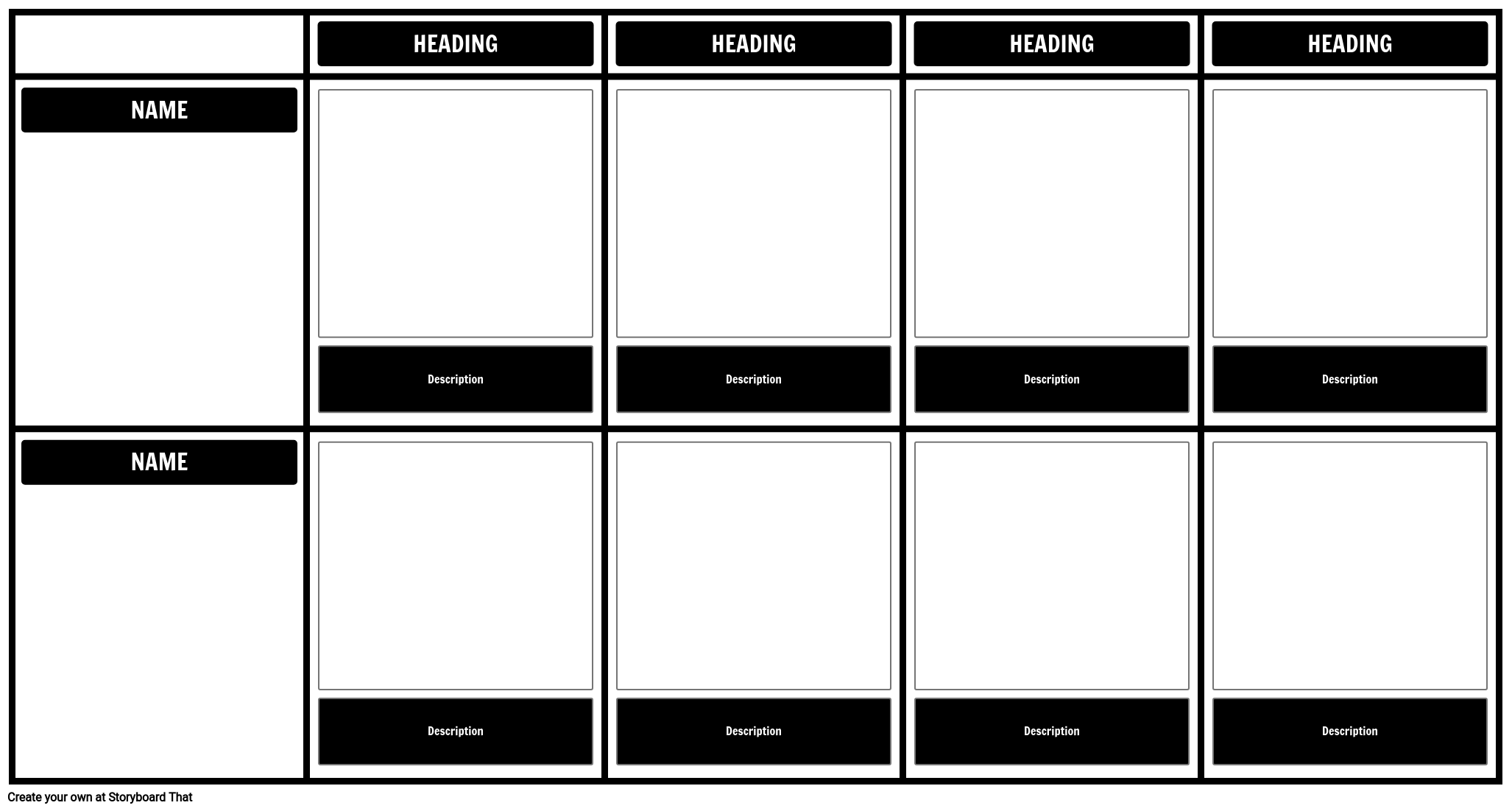
Lesson Plan Reference
Grade Level 6-8
Difficulty Level 2 (Reinforcing / Developing)
Type of Assignment Individual, Partner, or Group
Type of Activity: Compare and Contrast with T-Charts
(You can also create your own on Quick Rubric .)
Boy in the Striped Pajamas, The
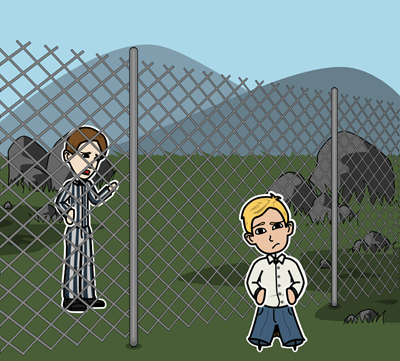
- 23154-Auschwitz • xiquinhosilva • License Attribution (http://creativecommons.org/licenses/by/2.0/)
- Auschwitz • jjmusgrove • License Attribution (http://creativecommons.org/licenses/by/2.0/)
- Barbed wire fence • kulmalukko • License Attribution (http://creativecommons.org/licenses/by/2.0/)
- Dachau Concentration Camp • dalecruse • License Attribution (http://creativecommons.org/licenses/by/2.0/)
- Dachau Concentration Camp mass grave • dalecruse • License Attribution (http://creativecommons.org/licenses/by/2.0/)
- Dachau Concentration Camp prisoners • dalecruse • License Attribution (http://creativecommons.org/licenses/by/2.0/)
- Dachau Concentration Camp workers • dalecruse • License Attribution (http://creativecommons.org/licenses/by/2.0/)
- Fenced blocks at Auschwitz I (Oświęcim, Poland 2014) • paularps • License Attribution (http://creativecommons.org/licenses/by/2.0/)
- Gas chamber, Auschwitz (7/11 gz08) • Ted and Jen • License Attribution (http://creativecommons.org/licenses/by/2.0/)
- Guarded fences of Auschwitz-Birkenau (Oświęcim, Poland 2014) • paularps • License Attribution (http://creativecommons.org/licenses/by/2.0/)
- prisoners at Dachau Concentration Camp • dalecruse • License Attribution (http://creativecommons.org/licenses/by/2.0/)
Try 1 Month For
30 Day Money Back Guarantee New Customers Only Full Price After Introductory Offer
Learn more about our Department, School, and District packages

- Thousands of images
- Custom layouts, scenes, characters
- And so much more!!
Create a Storyboard
Advertisement
One Area Where Biden Is Leading Trump: His Number of Donors
By Albert Sun , Scott Reinhard and Rebecca Davis O’Brien
President Biden may be struggling in national polls , but he recently overtook former President Donald J. Trump in at least one important measure: the total number of donors who have given to his campaign, which is often seen as a proxy for voter engagement.
The New York Times
Across most of the country, Mr. Trump has fewer donors than he did at the same time in 2020, while Mr. Biden has more.
Detailed maps of where people have donated to the Trump and Biden campaigns in 2024 and in 2020 show that Mr. Biden is overperforming and that Mr. Trump is underperforming in many of the battleground states they will need to win, in comparison with where they were at this point in the 2020 cycle.
As of the end of March, Mr. Biden had 1.1 million unique individual donors, compared with one million for Mr. Trump. The difference is apparent in their total fund-raising hauls : Mr. Biden's campaign committee has taken in nearly $160 million so far in this election cycle, compared with Mr. Trump's $114 million.
The rematch between the two candidates offers an unusual opportunity for comparison. A New York Times analysis of data on individual donors from filings with the Federal Election Commission shows that Mr. Trump had fewer individual donors at the end of March than he did at the same time in 2020, while Mr. Biden had more than he did in 2020.
Note: Lines show the total number of unique individual donors who gave to either Trump or Biden by the date of their first donation.
Mr. Biden’s robust fund-raising is in stark contrast to his weakness in the polls. New surveys from The Times, Siena College and The Philadelphia Inquirer show him trailing Mr. Trump in several crucial battleground states, as Mr. Biden’s popularity has eroded among young people and voters of color.
The two candidates’ positions have reversed since March 2020, when Mr. Trump was running for re-election and Mr. Biden was closing in on his party’s nomination.
Mr. Biden was a late-breaking favorite in the 2020 primary race, having lagged for months in the polls behind his Democratic rivals. He became the party’s presumptive nominee on April 8, after the withdrawal of Senator Bernie Sanders of Vermont.
This year, Mr. Trump was long the prohibitive favorite in the Republican primary race, but did not become the presumptive nominee until early March, when his last opponent, Nikki Haley, bowed out of the contest.
The changing circumstances between March 2020 and this year are also apparent outside of battleground states, when total donors to both candidates are compared with the previous cycle.
In Delaware, Mr. Biden has roughly twice as many donors as Mr. Trump, an analysis of contributions by ZIP codes shows. But compared with March 2020, he has lost ground to Mr. Trump – which makes sense, because Mr. Biden’s home state was the early donor engine of his primary campaign in 2019 and early 2020.
In New York City, Mr. Biden had a slight rise in donors relative to March 2020, while his number of donors in Manhattan has fallen steeply. The shift likely reflects his late emergence at the time as the party’s nominee. Mr. Trump has picked up donor support just outside the city on Long Island, which has been trending toward the Republican Party.
In Arizona, which is a battleground state in 2024, Mr. Biden has picked up donors. He won the state in 2020 but trails Mr. Trump in 2024 polls there.
On close inspection, a few ZIP codes stand out. At the end of March 2020, Mr. Biden had about 150 donors in the ZIP code 86001, which makes up part of Flagstaff. This year, he had almost 300. Mr. Trump’s donors there declined to about 130 from about 150. Many ZIP codes around Tucson, Phoenix and Scottsdale also had an increase in Biden donors.
In neighboring Nevada, Mr. Trump has generally drawn more donors in the Las Vegas area than he did in 2020. The Times’s latest polls found that Mr. Biden’s support in that state had dropped from 2020.
In Michigan, Mr. Biden had about 11 percent more donors than in 2020, driven by gains around Ann Arbor and in more traditionally conservative western parts of the state. But Mr. Biden did not gain donors in Dearborn, which has more residents with Middle Eastern ancestry or in Detroit, which is majority Black. Mr. Trump’s number of donors in the state fell by 8 percent, mostly because of dips in the Detroit suburbs and near Grand Rapids.
The latest Times/Siena polls show Mr. Trump leading among registered voters in Michigan, another battleground state.
North Carolina and South Carolina
The shifts in North Carolina and South Carolina are another illustration of how circumstances have changed for the two candidates. In South Carolina, Mr. Biden has lost donors compared with where he was in 2020, which makes sense: In 2020, the state had a competitive Democratic primary, which Mr. Biden won, setting off his march to the nomination. This year, it was Mr. Trump who had the competitive primary in South Carolina.
In North Carolina, a battleground state, Mr. Biden has gained donors relative to Mr. Trump since 2020. This could be welcome news for Democrats, who see the state as potentially winnable for Mr. Biden, after Mr. Trump won it narrowly in 2020.
Donors in battleground states in the 2024 cycle
Notes: Bars show the estimated number of individual donors who have given to each candidate in each state as of March 31. Numbers are estimates because of potential duplicate names or changes of address within the data.
Methodology
Data includes donations reported to the Federal Election Commission by the Trump 2020 campaign, the Trump 2024 campaign, Trump Make America Great Again Committee, the Trump Victory joint fund-raising committee, Trump Save America Joint Fundraising Committee, Trump 47 Committee, Trump National Committee JFC, the Biden campaign, the Biden Victory Fund joint fund-raising committee and the Biden Action Fund joint fund-raising committee. Additional donations processed on behalf of those committees and reported by the online fund-raising platforms ActBlue and WinRed are also included.
The estimated number of individual donors was determined based on a unique combination of contributor name, state and ZIP code. Donors with invalid addresses were filtered out of the analysis. Dates of first donation were determined by the earliest contribution date for a unique individual donor to a 2020 or 2024 committee affiliated with either candidate.
Donations are counted through March 31 starting from the earliest announcement by one of the two candidates each cycle: April 25, 2019, for Mr. Biden in the 2020 cycle and November 15, 2022, for Mr. Trump in the 2024 cycle.
Areas where the number of donors changed by five or fewer are not shown.
- Share full article
Our Coverage of the 2024 Election
Presidential Race: News and Analysis
President Biden railed against “extremist forces” and drew contrasts with Donald Trump in a commencement address to hundreds of young Black men at Morehouse College.
Biden’s narrow win in Georgia in 2020 was seen as a sign of the state’s emergence as a battleground. But in 2024, he faces a changed landscape there .
Senator Marco Rubio of Florida, who has been floated as a possible running mate for Donald Trump, refused to commit to accepting the results of the 2024 election .
Political Violence: Public officials from Congress to City Hall are now regularly subjected to threats of violence. It’s changing how they do their jobs .
Trump’s Running Mate: Trump’s V.P. search is still in its early stages, but he is said to be leaning toward more experienced options who can help the ticket without seizing his precious spotlight.
Biden-Trump Debates: How might the candidates try to win their two planned debates? Veteran Republican and Democratic strategists offered their advice .
Burning Cash: It is a time-honored tradition in U.S. politics: wealthy people burning through their fortunes to ultimately lose an election. Here are some of the biggest money-pit campaigns .

IMAGES
VIDEO
COMMENTS
A significant difference between books and movies is in the manner in which the visual images are created. When reading a book, the reader has to use his/her imagination to create a visual image from the words contained in the book (Mayer 17). For example, in the Harry Potter books, the reader is required to form his/her own image of the ...
Find a focus and outline your ideas. At this point, you have a solid list of relevant points to analyze, but you still don't have a focus for your paper. To start, develop a solid thesis statement. Don't write a bland statement like, "There are many similarities, but only a few differences between the book and movie.".
First, you can write about each thing separately and then include a section in which you make comparisons and contrasts between them. With this organization, you would first write about the strengths and weakness of the book, and then about the movie. In a third section you would make a series of statements comparing and contrasting major ...
Books and movies share many similarities, such as the use of characters, plot, setting, and themes. Both books and movies can tell stories, evoke emotions, and explore ideas. Additionally, both books and movies can be adapted from other works, such as plays or other books. Finally, both books and movies can be used to entertain, educate, and ...
Books are great because they allow the reader to be a part of the story; we are the observers that have insight into the character's thoughts and feelings, and all the nuances that create three-dimensional characters. With books, there's just more. More detail, more focus on character development, and more depth to the meaning of the artwork.
Step 3: Choose a Film for Comparison. The key to a good comparison essay is to choose two subjects that connect in a meaningful way. The purpose of conducting the comparison is not to state the obvious, but rather to illuminate subtle differences or unexpected similarities. When writing a film comparison paper, the point is to make an argument ...
Charlie and the Chocolate Factory. Holes. James and the Giant Peach. Stellaluna. Cloudy With a Chance of Meatballs. Mrs. Frisby and the Rats of NIMN. Where the Red Fern Grows. Polar Express (a great option for a fun Christmas activity) The Lion, the Witch, and the Wardrobe.
A book versus movie comparison provides an excellent opportunity for students to think critically about specific details, make connections between written and visual mediums, and focus on the concept of visualization. The questions listed below are designed to get students thinking about the similarities and differences between the information ...
Book and Movie Comparison/Contrast Guide Setting: Ways that the book and movie are the same include… Setting: Ways that the book and movie are different include… Characters: Ways that the book and movie are the same include… Characters: Ways that the book and movie are different include…
Overview. Movies can be an integral part of the language arts classroom when they are used in ways that encourage and develop students' critical thinking. In this activity, students explore matching texts—novels and the movies adapted from them—to develop their analytical strategies. They use graphic organizers to draw comparisons between ...
2021/08/22 by Simon White Compare and Contrast Essay Samples, Free Essay Samples. Last modified on November 26th, 2021. ... This led to making a comparison of films vs. movies. Book reading and movie watching are the two most fundamental ways of conveying ideas to the spectators. Books and movies can be utilized for several purposes. For ...
Books often provide a deeper insight into the thoughts and emotions of the characters, allowing the reader to immerse themselves in the story on a more personal level. In contrast, movies rely on visual and auditory elements to convey the story, offering a more immediate and sensory experience for the audience.
By Dennis K. Hawkins March 19, 2023. The debate between books vs. movies has been raging for decades. Some people prefer the immersive experience of reading a good book, while others enjoy the visual and auditory spectacle of a blockbuster movie. While both mediums have their own unique advantages and disadvantages, there is no denying that ...
Jane Austen's timeless novel "Pride and Prejudice" has captured the hearts of readers for centuries, and its. enduring appeal has led to multiple adaptations in various forms of media. One of the most notable adaptations is. the movie version, which introduces the story to a wider audience. This essay delves into the similarities and.
Use this CliffsNotes To Kill a Mockingbird Study Guide today to ace your next test! Get free homework help on Harper Lee's To Kill a Mockingbird: book summary, chapter summary and analysis, quotes, essays, and character analysis courtesy of CliffsNotes. In To Kill a Mockingbird , author Harper Lee uses memorable characters to explore Civil Rights and racism in the segregated southern United ...
Get free homework help on Ray Bradbury's Fahrenheit 451: book summary, chapter summary and analysis, quotes, essays, and character analysis courtesy of CliffsNotes. In Ray Bradbury's Fahrenheit 451, you journey to the 24th century to an overpopulated world in which the media controls the masses, censorship prevails over intellect, and books are considered evil because they make people question ...
Book vs. Movie Graphic Organizer . Step One: Organize Your Thoughts As you watch the movie, write down the similarities and differences you notice between the book and the movie. After watching, explain how each difference changed the story. Finally, think about how reading the book before the movie affected your understanding of the story.
In each case, Beowulf goes to face the dragon with a group of men but arrives at the dragon's lair with only a single helper, a young kinsman in the book, and an aging friend in the film. Many of the key events of the actual battle between dragon and man remain the same as well. Beowulf is driven off by flame, is failed by his sword, and must ...
identify the main events in a story. compare and contrast a book and its movie adaptation. analyze the choices directors make in creating a movie based on a book. write a critique on the film adaptation of the book. Workplace Readiness Skill: (place an X in front of all which apply) X Social Skills X Communication. X Teamwork X Critical Thinking.
Top 10 Differences Between the Book and the Movie. 1) The movie takes place in the Midwest, not in Syracuse, New York. 2) The mascot only changes once in the movie, from Trojan to Hornet. 3) Melinda meets Heather on the school bus in the movie, not in the cafeteria. 4) In the movie, Melinda is raped in Andy's car, not outside of the party.
The Great Gatsby is one of the key novels that depicts the struggle for freedom and identity with the enormous challenges in society. It is a novel that was written in 1925 by American author F. Scott Fitzgerald. The story follows a series of characters who are living in a fictional town of West Egg and East Egg.
After both reading the book The Boy in the Striped Pajamas and watching the movie, students should be able to identify many similarities and differences. While reading, students can often let their imaginations create the characters and settings. When viewing a movie that has been based off of a book, the characters or settings may seem different than what the reader imagined them to be.
Mr. Biden's robust fund-raising is in stark contrast to his weakness in the polls. New surveys from The Times, Siena College and The Philadelphia Inquirer show him trailing Mr. Trump in several ...